Belkin F8T020V2 Bluetooth PDA & PC Combo Card User Manual BT 0101M User s Guide
Belkin International, Inc. Bluetooth PDA & PC Combo Card BT 0101M User s Guide
Belkin >
Manual revised

Bluetooth
Compact Flash Card
User’s Guide
Version 1.0

REGULATORY INFORMATION
Federal Communications Commission Interference Statement
The equipment has been tested and found to comply with the limits for a Class B
digital device, pursuant to part 15 of the FCC Rules. These limits are designed to
provide reasonable protection against harmful interference in a residential
installation. This equipment generates, uses and can radiate radio frequency
energy and, if not installed and used in accordance with the instruction, may
cause harmful interference to radio communication. However, there is no
guarantee that interference will not occur in a particular installation. If this
equipment dose cause harmful interference to radio or television reception, which
can be determined by turning the equipment off and on, the user is encouraged
to try to correct the interference by one of the following measures:
• Reorient or relocate the receiving antenna.
• Increase the separation between the equipment and receiver.
• Connect the equipment into an outlet on a circuit different from that to which the
receiver is connected.
• Consult the dealer or an experienced radio/TV technician for help.
FCC Caution: To assure continued compliance, (example – use only shielded
interface cables when connecting to computer or peripheral devices). Any
changes or modification not expressly approved by the party responsible for
compliance could void the user’s authority to operate this equipment.
This device complies with Part 15 of FCC Rules. Operation is subject to the
following two conditions: (1) This device may not cause harmful interference, and
(2) this device must accept any interference received, including interference that
may cause undesired operation.
IMPORTANT NOTE:
This transmitter must not be co-located or operating in conjunction with any
other antenna or transmitter.

EUROPEAN COMMUNITY CE NOTICE
Marking by the symbol CE indicates compliance of this equipment to the R&TTE
Directive 1999/5/CE. Such marking is indicative that this equipment meets or
exceeds the following technical standards:
• EN 300 328
• EN 301 489 -1, EN 301 489 -17
• EN 60950

LICENSED SOFTWARE
© Copyright 2000 – 2002, WIDCOMM, Inc. (“WIDCOMM”). All rights reserved.
WARNING: This software and accompanying documentation are protected by copyright law and
international treaties. Unauthorized reproduction or distribution of this software, or any portion of it, may
result in severe civil and criminal penalties, and will be prosecuted to the maximum extent possible under
the law.
Use of this software is governed by the terms of the end user license agreement that accompanies or is
included with such software. Unless otherwise noted in the end user license agreement, or herein, no part of
the documentation accompanying this software, whether provided in printed or electronic form may be
reproduced in any form, or stored in a database or retrieval system, or transmitted in any form or by any
means, or used to make any derivative work (such as translation, transformation, or adaptation) without the
express, prior written consent of WIDCOMM.
Registered Trademark(s) ®, Trademark(s)™, and Service Mark(s)SM
WIDCOMM, and the WIDCOMM logo are trademarks of WIDCOMM, Inc.
Bluetooth and the Bluetooth logos are trademarks of the Bluetooth SIG, Inc., U.S.A. and licensed to
WIDCOMM, Inc.
Compaq and iPAQ are trademarks of Compaq Information Technologies Group, L.P.
Microsoft, Windows, Outlook, ActiveSync, and the Windows CE logo (graphic only) are either registered
trademarks or trademarks of Microsoft Corporation in the United States and/or other countries.
Other brand and product names may be registered trademarks, service marks, or trademarks of their
respective holders.

Bluetooth Complact Flash Card Table of Contents
Table of Contents
1 INTRODUCTION TO BTW-CE.........................................................................................................1
1.1 BLUETOOTH ICON ...........................................................................................................................1
1.2 APPLY POWER TO THE BLUETOOTH HARDWARE .............................................................................1
1.3 INSTALLATION ................................................................................................................................2
1.3.1 Integrated (Built-in) Bluetooth Hardware...........................................................................2
1.3.2 External (Add-on) Bluetooth Hardware..............................................................................2
1.3.2.1 Requirements.....................................................................................................2
1.3.2.2 Installation .........................................................................................................2
1.4 UNINSTALL A PRIOR VERSION OF BTW-CE.....................................................................................3
2 BLUETOOTH CONTROL PANEL: CONFIGURING BTW-CE...................................................4
2.1 GENERAL TAB ................................................................................................................................6
2.1.1 Profiles................................................................................................................................8
2.1.1.1 Create A New Profile ........................................................................................8
2.1.1.2 Rename or Delete a Profile................................................................................8
2.1.1.3 Save Configuration Settings In A Profile ..........................................................9
2.2 ACCESSIBILITY TAB ......................................................................................................................10
2.3 BTW-CE SERVICE TABS ..............................................................................................................11
2.3.1 Common Options..............................................................................................................12
2.3.2 File Transfer Tab ..............................................................................................................13
2.3.3 Information Exchange Tab ...............................................................................................14
2.3.4 Serial Port Tab ..................................................................................................................15
2.3.5 Dial-up Networking Tab...................................................................................................16
2.4 ABOUT TAB ..................................................................................................................................17
3 BLUETOOTH MANAGER: USING BTW-CE...............................................................................18
3.1 TABS .............................................................................................................................................20
3.1.1 My Shortcuts Tab .............................................................................................................20
3.1.1.1 Connection Open—Context Sensitive Menu Options .....................................21
3.1.1.2 Connection Status Screen ................................................................................21
3.1.1.3 Connection Inactive—Context Sensitive Menu Options.................................22
3.1.1.4 Connection Properties Screen..........................................................................23
3.1.2 Active Connections Tab....................................................................................................24
3.2 MENUS..........................................................................................................................................25
3.2.1 New...................................................................................................................................25
3.2.1.1 Connection shortcut….....................................................................................26
3.2.1.2 Temporary connection….................................................................................28
3.2.2 Security.............................................................................................................................29
3.2.2.1 Trusted devices................................................................................................29
3.2.2.2 Permissions......................................................................................................30
3.2.3 View .................................................................................................................................31
3.3 ICONS............................................................................................................................................31
3.3.1 New Connection Shortcut ...........................................................................................31
3.3.2 Business Card Exchange............................................................................................31
4 USING REMOTE DEVICE SERVICES..........................................................................................32
4.1 SERIAL PORT.................................................................................................................................32
4.2 DIAL-UP NETWORKING: CONNECT TO A REMOTE COMPUTER ......................................................32
4.3 BLUETOOTH FILE EXPLORER ........................................................................................................34
4.3.1 Change the Remote Device Folder ...................................................................................36
4.3.2 File Menu..........................................................................................................................36
4.3.2.1 Send a File to the Remote Device....................................................................36
4.3.2.2 Create a Folder on the Remote Device ............................................................36
4.3.2.3 Get a File From the Remote Device ................................................................36
4.3.2.4 Delete a File on the Remote Device ................................................................36
4.3.3 Tools Menu.......................................................................................................................37
4.3.3.1 Set Local Folder...............................................................................................37
4.3.3.2 Refresh.............................................................................................................37
4.4 SEND VIA BLUETOOTH ..................................................................................................................37

BTW-CE User’s Guide List of Figures
List of Figures
Figure 1: ActiveSync's Tools > Add/Remove Programs... dialog box........................................................3
Figure 1: Control Panel tabs scroll arrows ..................................................................................................4
Figure 2: Configuration overview...............................................................................................................5
Figure 3: Control Panel, General tab, integrated hardware .........................................................................6
Figure 4: Control Panel, General tab, external hardware ............................................................................7
Figure 5: Control Panel, Accessibility tab.................................................................................................10
Figure 6: Bluetooth Passkey screen ..........................................................................................................12
Figure 7: Control Panel, File Transfer tab.................................................................................................13
Figure 8: Control Panel, Information Exchange tab..................................................................................14
Figure 9: Control Panel, Serial Port tab ....................................................................................................15
Figure 10: Control Panel, Dial-up Networking tab .....................................................................................16
Figure 11: Control Panel, About tab ...........................................................................................................17
Figure 12: Bluetooth Manager Menu/Toolbar ............................................................................................19
Figure 13: Connection status displayed by icon color.................................................................................20
Figure 14: Connection Status screen...........................................................................................................21
Figure 15: Connection Properties screen.....................................................................................................23
Figure 16: Active Connections screen, signal strength indicator ................................................................24
Figure 17: Bottom of the Select a device wizard screen (composite overview)..........................................25
Figure 18: Connection Wizard, specific service chosen, last screen...........................................................27
Figure 19: Authorization Requested ...........................................................................................................30
Figure 20: Dial-up Networking overview ...................................................................................................32
Figure 21: Dial-up Networking, overview (composite screenshot).............................................................33
Figure 22: Bluetooth File Explorer overview (composite screenshot)........................................................35
Figure 23: Send via Bluetooth menus .........................................................................................................37
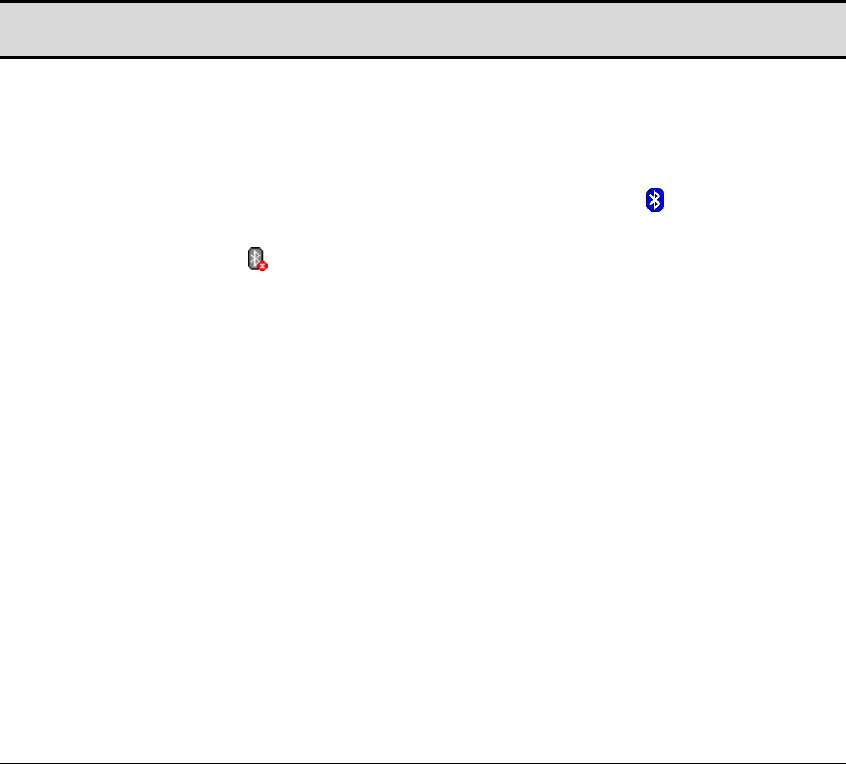
Bluetooth Compact Flash Card Introduction
1
1 Introduction To BTW-CE
BTW-CE is the solution for the seamless integration of Bluetooth technology into devices
that use the Pocket PC operating system. It provides Pocket PCs with the means to:
• Locate other Bluetooth devices in the immediate vicinity (inquiry)
• Discover the services that those devices offer (discovery)
• Connect to, use, and disconnect from those services
• Enable/disable individual services
• Security features, on a service-by-service basis, including:
Authentication
Authorization
Encryption.
This User’s Guide is divided into four major sections:
• Introduction
• Configuring BTW-CE—see the sections on the Bluetooth Control Panel
• Using BTW-CE—see the sections on the Bluetooth Manager
• Using Remote Device Services—an overview of how to use services provided by
remote Bluetooth devices.
NOTE: If your Pocket PC uses external (not built-in) Bluetooth hardware, see section 1.3.2 for
installation assistance.
1.1 BLUETOOTH ICON
The Bluetooth icon in the lower-right corner of the Today screen provides quick access to
the Bluetooth Control Panel.
It also provides visual feedback about whether Bluetooth is “on” or “off”:
• When BTW-CE is active (“on”) the Bluetooth icon is blue .
• If BTW-CE is disabled (“off”) the icon appears grayed with a red X in the lower
right corner .
1.2 APPLY POWER TO THE BLUETOOTH HARDWARE
If the Bluetooth hardware is an integral part of the device (built-in), the first screen of the
Bluetooth Control Panel has ON/OFF buttons to apply/remove power to the hardware
(Figure 4).
When the Bluetooth hardware is an expansion device, power is applied/removed by
inserting/removing the card (Figure 5).
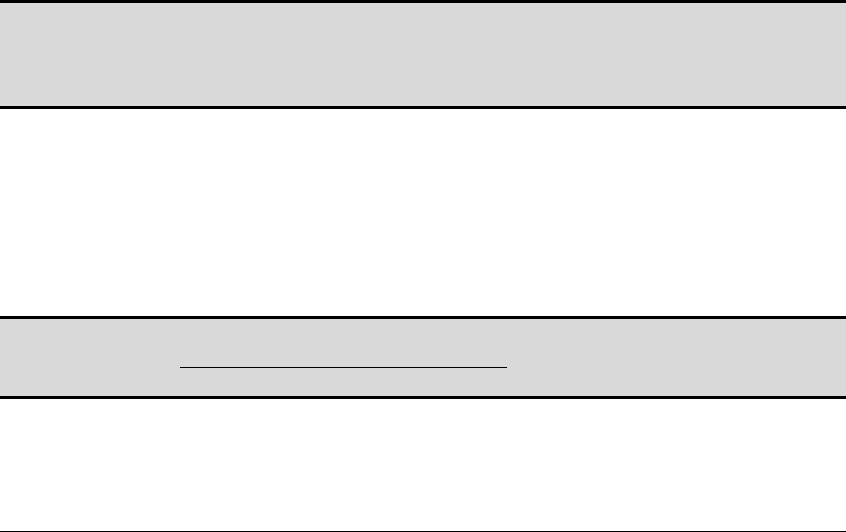
Bluetooth Compact Flash Card Introduction
2
1.3 INSTALLATION
1.3.1 Integrated (Built-in) Bluetooth Hardware
BTW-CE is factory-installed in Flash memory on your device; no installation is required.
1.3.2 External (Add-on) Bluetooth Hardware
If a prior version of BTW-CE is installed on the handheld computer it must be uninstalled
before proceeding. See Section 1.4 for uninstall instructions.
1.3.2.1 Requirements
1. A desktop computer with:
Microsoft Windows 98SE, Me, 2000 or XP operating system
CD-ROM drive
Microsoft ActiveSync, version 3.0 or greater.
2. A handheld computer capable of accepting a CompactFlash card
3. One of the following Bluetooth CompactFlash cards:
a) Brainboxes
b) Samsung
c) Sharp.
1.3.2.2 Installation
1. Insert the Bluetooth CompactFlash card into the handheld device and connect it
to the desktop computer. Microsoft ActiveSync will automatically establish a
connection.
2. On the desktop computer:
a) Insert the BTW-CE compact disc into the CD-ROM drive.
b) When the Welcome screen appears, Click Next to continue.
c) Click Yes to accept the License Agreement and install the software on the
desktop computer.
NOTE: If the connection between the handheld and the desktop computers is not open, an error
message appears: “On the next PDA connection, the installed applications will be
downloaded to the device.” Installation will resume when ActiveSync detects a
connection to handheld device.
3. On the handheld device: tap Yes to accept the default directory and install the
software.
4. On the desktop computer: Click OK to close the Download Complete dialog box,
and then click Finish.
5. On the handheld device:
a) Follow any on-screen instructions that may appear.
b) Perform a “soft” reset of the handheld computer.
NOTE: A soft reset leaves installed applications and stored data intact.
A hard reset deletes ALL downloaded applications on the handheld.
See the handheld computer’s documentation for additional information.
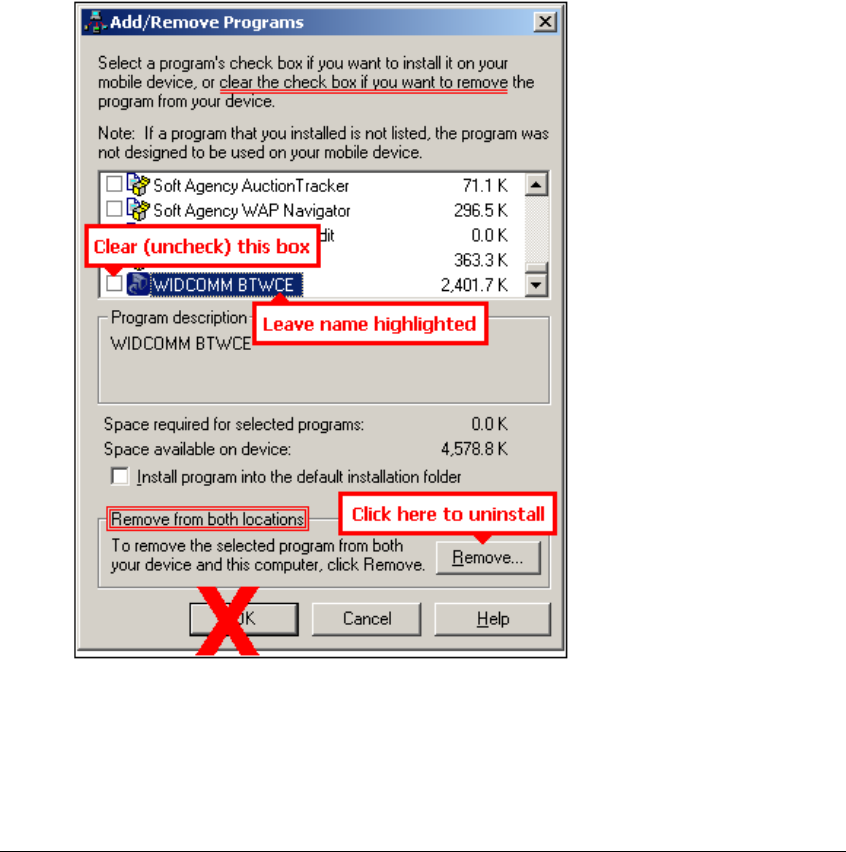
Bluetooth Compact Flash Card Introduction
3
1.4 UNINSTALL A PRIOR VERSION OF BTW-CE
1. Connect the handheld computer, via its cradle and Microsoft ActiveSync, to the
desktop computer.
2. On the desktop computer, in the system tray, double-click the ActiveSync icon.
3. From the ActiveSync Tools menu, click Add/Remove Programs…
4. In the list of applications installed on the handheld computer, clear (un-check)
WIDCOMM BTWCE. Verify that WIDCOMM BTWCE is still highlighted
(see Figure 1).
5. Click the Remove button (DO NOT click the OK button, see Figure 1).
6. Click OK to acknowledge the Remove Application notification.
The prior version of BTW-CE will be uninstalled on both the handheld and desktop
computers (follow any additional on-screen instructions may appear on the desktop
computer to complete the uninstall process).
Figure 1: ActiveSync's Tools > Add/Remove Programs... dialog box
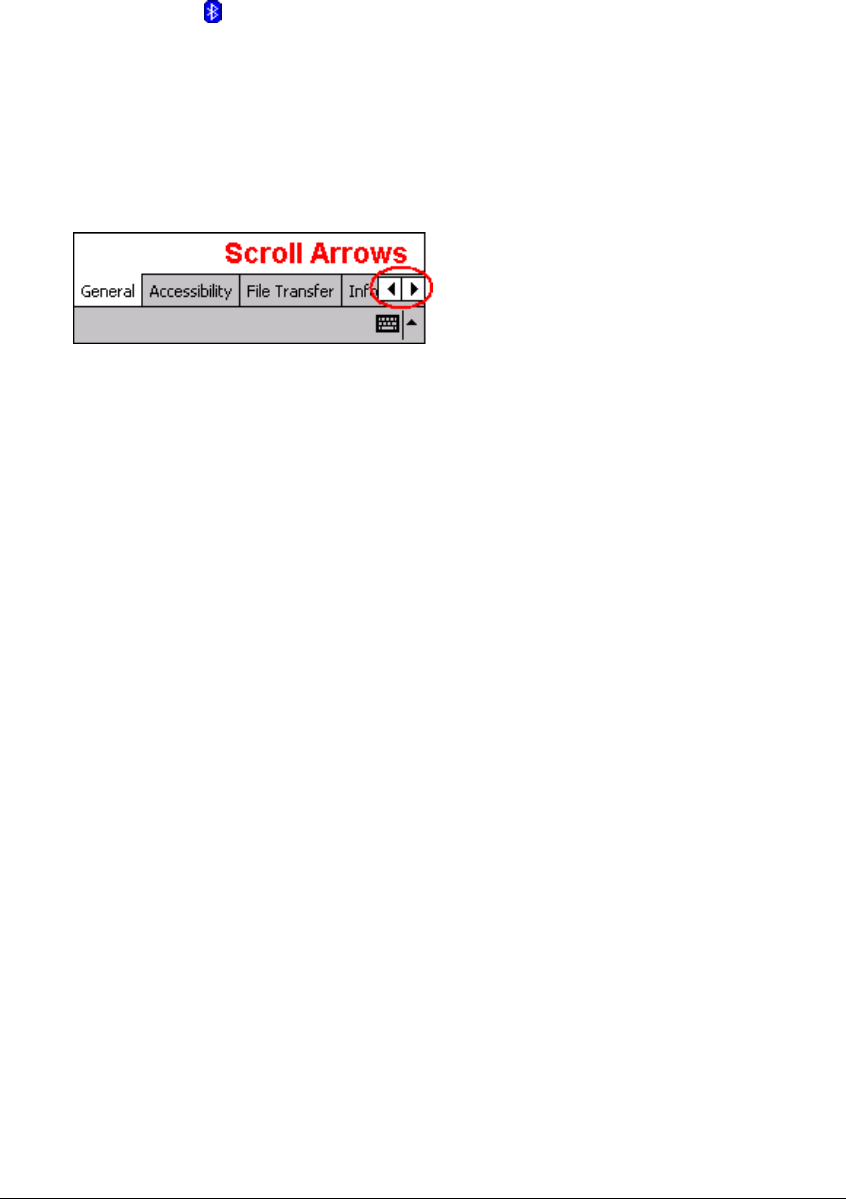
BTW-CE User’s Guide Control Panel
4
2 Bluetooth Control Panel: Configuring BTW-CE
BTW-CE provides a Control Panel to adjust Bluetooth settings.
To access the Control Panel, in the lower-right corner of the Today screen, tap the
Bluetooth icon .
BTW-CE can have multiple saved configurations. Individual configuration sets are saved
in profiles, which can be quickly loaded to meet the appropriate situation. See
Section 2.1.1 for more information about profiles.
The Control Panel has seven tabs. All tabs are not visible on the screen at the same time;
use the arrows (Figure 2) to the right of the tab names to scroll back-and-forth and expose
the different tabs.
Figure 2: Control Panel tabs scroll arrows
The Control Panel’s tabs are (see Figure 3):
• General
User profile selection
Bluetooth status (ON/OFF) indicator
Hardware power control (ON/OFF).
• Accessibility
Set the device name
The device’s Bluetooth Device Address (BDA)
Determine which remote devices are allowed to connect
Determine whether remote devices can “see” this Pocket PC.
• Service tabs—BTW-CE can provide four services. They are:
File Transfer—set the highest-level directory on this Pocket PC that remote
devices will be able to access.
Information Exchange—Set the default business card (Pocket Outlook
contact entry)
Serial Port—Bluetooth serial port information
Dial-up Networking—configure the COM port, baud rate and flow control.
• About—there are no configurable options on this tab.
Software version information
Copyright information
Website and Technical Support links.
Each of these tabs is explained in detail in the remainder of this section.
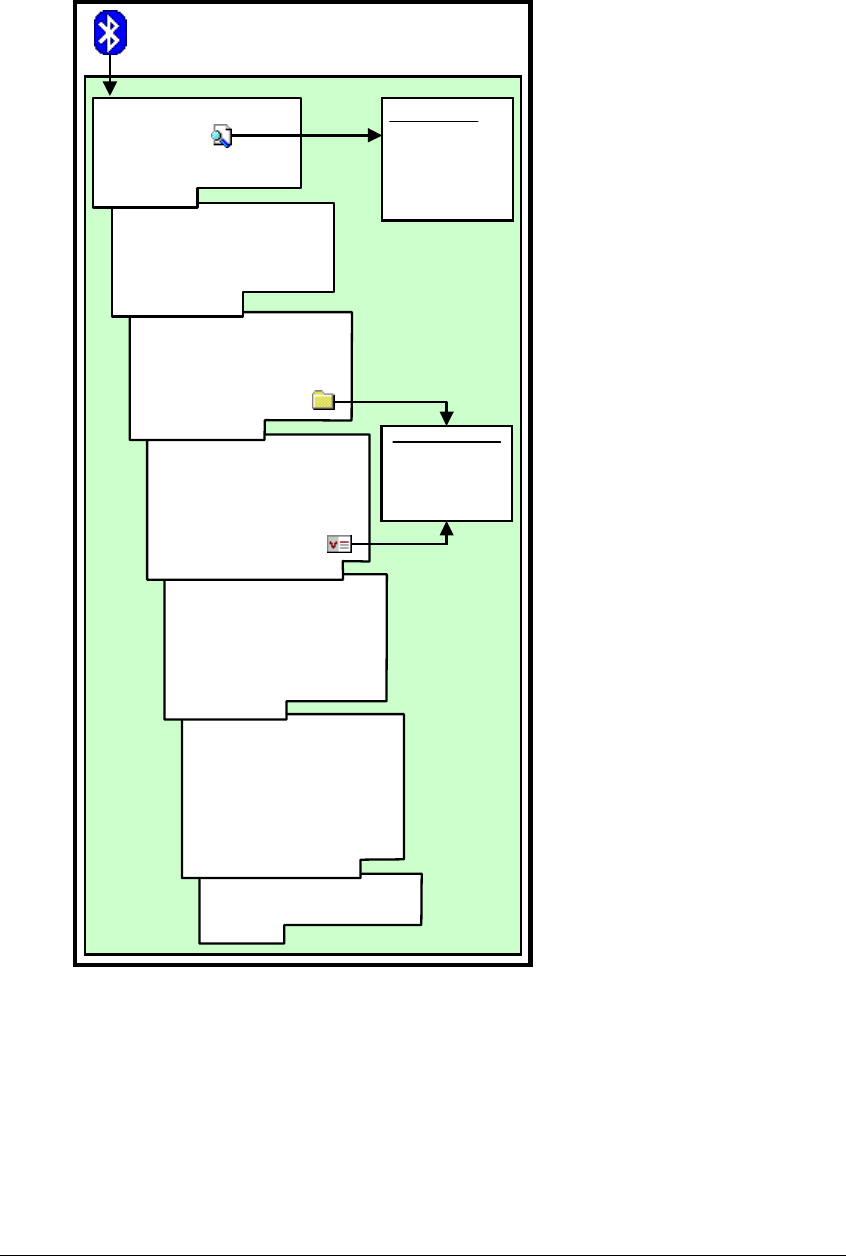
BTW-CE User’s Guide Control Panel
5
Figure 3: Configuration overview
Display:
Software Version Data
About
Enable: This Service
Authorization
Authentication
Encryption
Set: COM port
Baud rate
Flow control
Dial-up Networking
Enable: This Service
Authorization
Authentication
Encryption
Display: Inbound COM port
Outbound COM port
Serial Port
Enable: This Service
Authorization
Authentication
Encryption
Set & Display:
My bus. card
Information Exchange
Profile page
Profile
functions:
New
Rename
Delete
Browse Dialog
Locate & Set
Directory
or
Contact
Bluetooth Control Panel
Tap the Bluetooth icon on the Today page
Enable: This Service
Authorization
Authentication
Encryption
Set: My shared folder
File Transfer
Set: Device name
Devices with access
Discoverability
Display: BDA
Accessibility
(Default tab)
Select: Profile
Set: Bluetooth ON/OFF
Display: Status ON/OFF
General
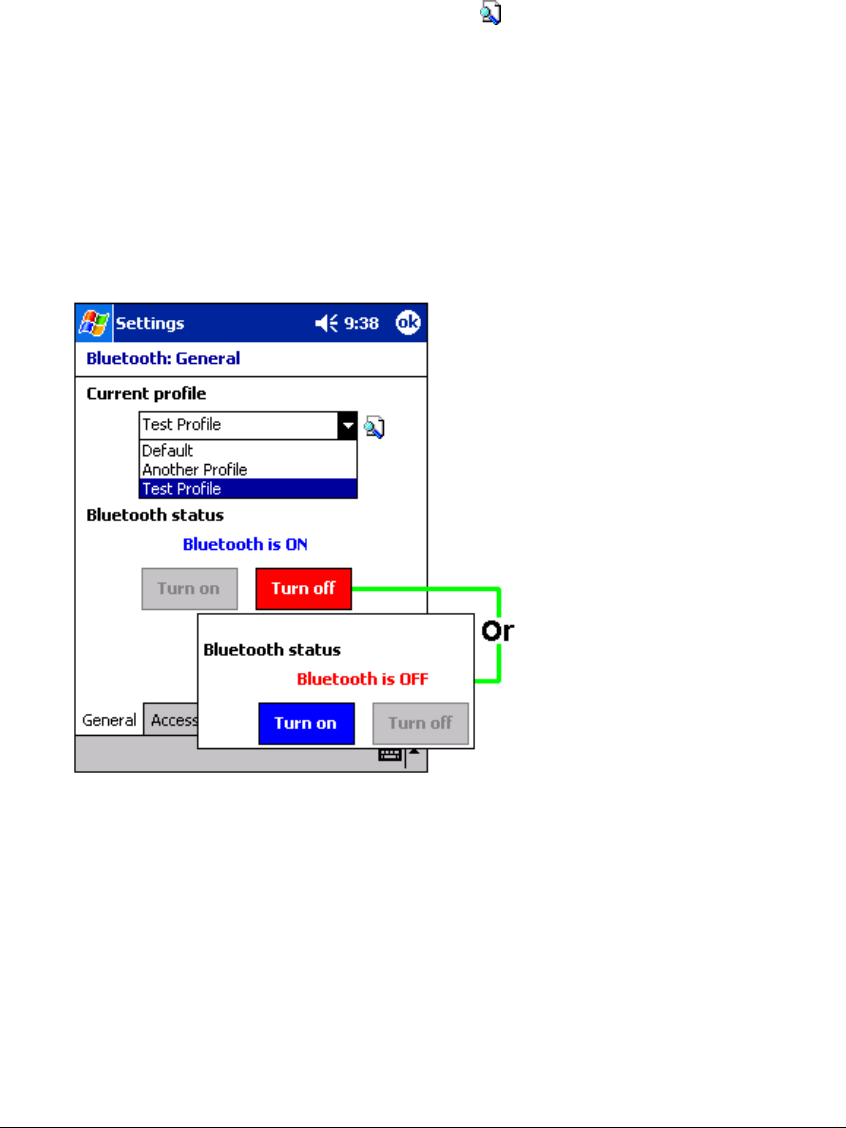
BTW-CE User’s Guide Control Panel
6
2.1 GENERAL TAB
There are two options on this screen:
• Current Profile: to change the active profile, tap the down-arrow in the
“Current profile:” field and select the new profile from the drop-down list. The
current profile will be saved, and the settings from the selected profile will be
loaded.
To add, delete, or rename a profile, tap (see Section 2.1.1).
• Bluetooth Status:
Integrated Bluetooth hardware (see Figure 4)
External Bluetooth hardware (CompactFlash or PC expansion card) (see
Figure 5 on the next page).
When Bluetooth is OFF, no connections, incoming or outgoing, are possible.
When Bluetooth is ON, Bluetooth is always “up” and battery drain is significantly greater
than when Bluetooth is disabled. To conserve battery power, do not enable Bluetooth
when it is not being used.
Figure 4: Control Panel, General tab, integrated hardware
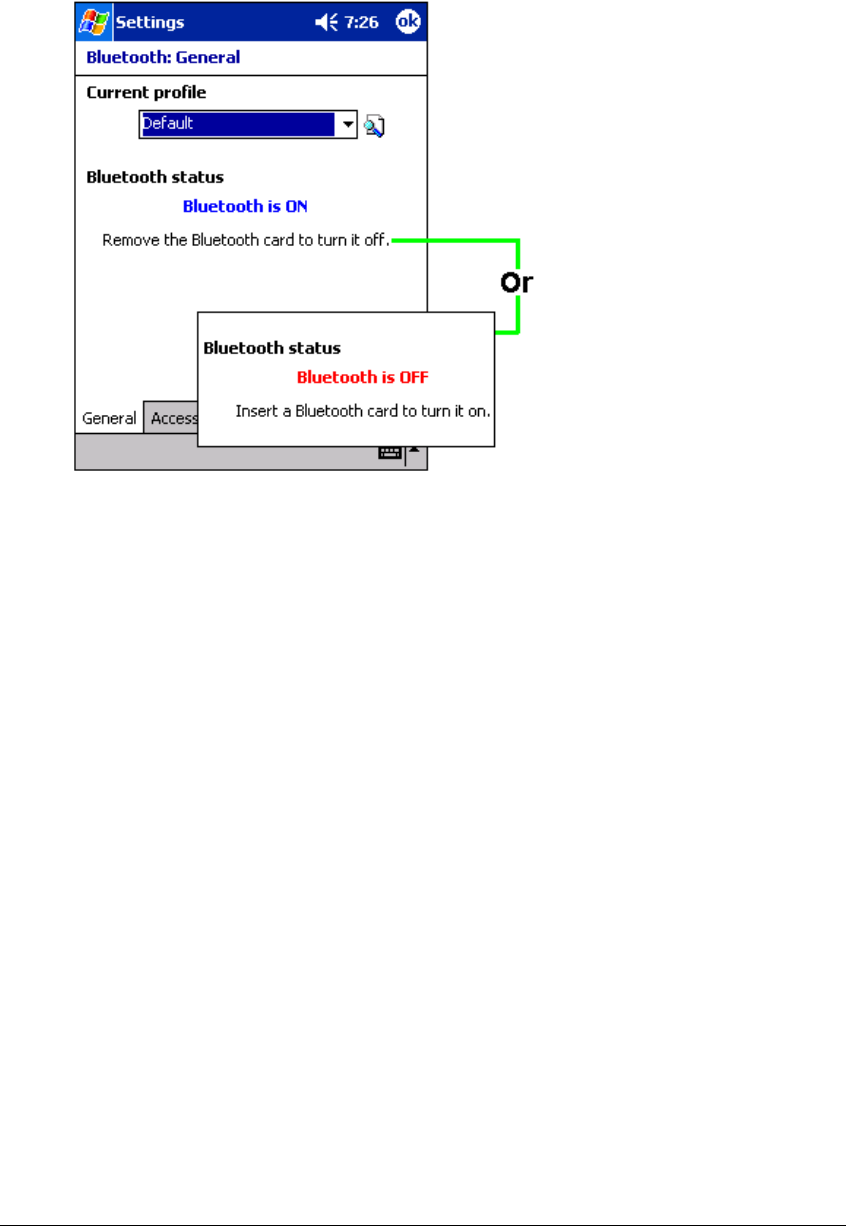
BTW-CE User’s Guide Control Panel
7
Figure 5: Control Panel, General tab, external hardware
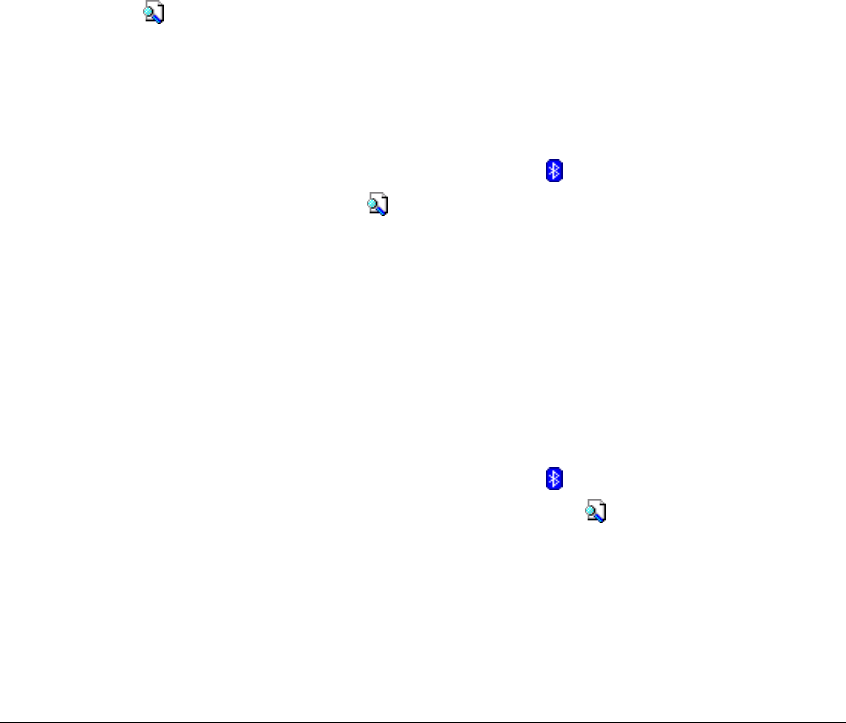
BTW-CE User’s Guide Control Panel
8
2.1.1 Profiles
Profiles are accessed and managed from the Control Panel, General Tab. They allow:
• Different users to quickly re-configure a Pocket PC to their personal preferences.
For example, if Joe and Mary both use the same Pocket PC, but each uses it for a
different purpose, selecting a pre-configured profile will alter the settings to those
of the appropriate user.
• A single user to quickly re-configure a Pocket PC for a different environment. If
Joe uses his device primarily at the office, but also uses it when traveling, he can
easily switch to a pre-configured profile, which has more secure settings for hotel,
airport and similar “public” environments.
All Bluetooth settings are saved in the active profile. A profile named “Office,” for
example, may include Bluetooth Authentication and Encryption settings, and connection
shortcuts to specific services on work-related Bluetooth devices. A profile named
“Public” on the same device may only allow the owner’s laptop computer to connect to
the Pocket PC. When the “Public” profile is selected, only the Bluetooth settings related
to that profile are active, the “Office” profile settings have no affect.
When the Pocket PC is turned off, BTW-CE saves the last-used profile and reloads that
profile the next time the device is turned on.
The Profile options (available from the Control Panel, General Tab) are:
• A list of existing profiles—when BTW-CE is started for the first time the only
profile listed will be “Default.” To enable a profile, tap it.
• accesses a screen from which you can:
Add a profile
Rename a profile
Delete a profile.
2.1.1.1 Create A New Profile
1. From the Today screen, tap the Bluetooth icon .
2. From the General tab, tap .
3. From the Add/Delete Profiles screen:
a) Tap the New button
b) Enter a descriptive name for the new profile, for example, “Office.”
c) Select an existing profile on which to base the new profile.
4. Tap the OK button.
The new profile does NOT automatically become the active profile; to activate the new
profile, select it from the “Current Profile” field on the General Tab.
2.1.1.2 Rename or Delete a Profile
1. From the Today screen, tap the Bluetooth icon .
2. From the Bluetooth Control Panel, General tab, tap .
3. From the Add/Delete Profiles screen:
a) Tap a profile name, then the Rename button and enter the new name.
Or
b) Tap a profile name, then the Delete button.
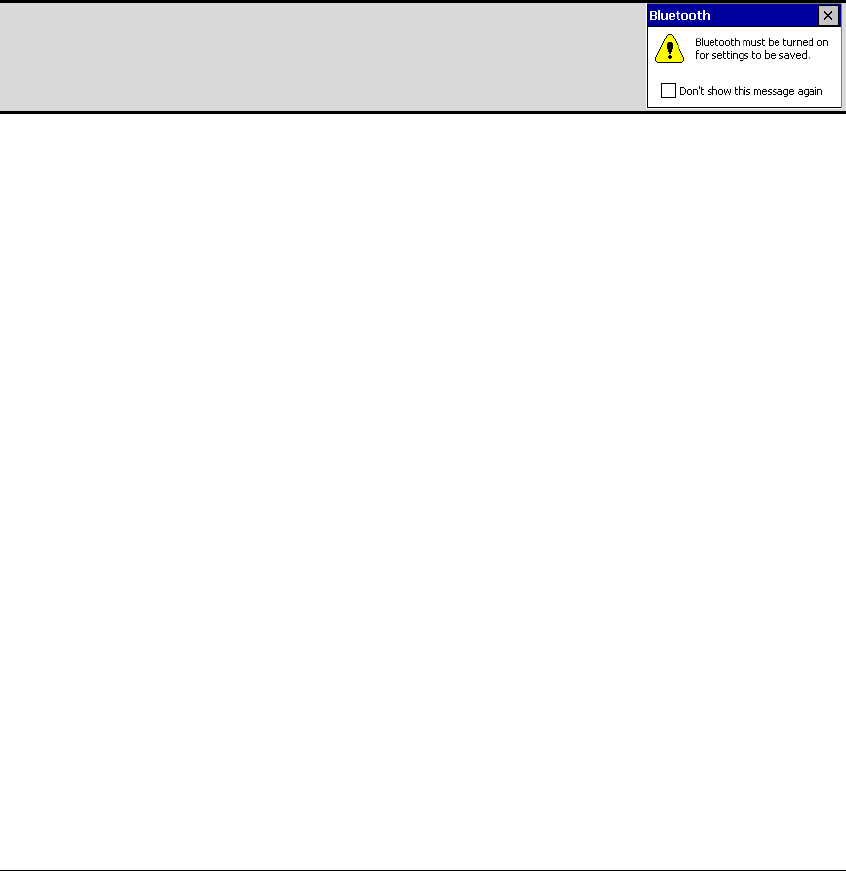
BTW-CE User’s Guide Control Panel
9
2.1.1.3 Save Configuration Settings In A Profile
When you make changes to the Pocket PC’s configuration, those changes are
automatically saved when you select a different profile, turn Bluetooth off, or shut down
the Pocket PC.
To save a specific configuration:
1. Select (or create and then select, see Section 2.1.1.1) the desired profile (for
example “Travel”) from the Current Profile field on the General Tab.
2. Setup the Pocket PC (see Section 2) so that it behaves in the desired manner.
3. Tap OK
4. Close the Control Panel; the changes are saved automatically.
To use the Travel profile and its associated configuration in the future, from the Control
Panel, General Tab, select “Travel” from Current Profile drop-down list.
To avoid saving unwanted changes to a regularly used profile, create a new profile that is
based on the profile currently in use (see Section 2.1.1.1), select the new profile, and then
make the changes while the new profile is active.
NOTE: If Bluetooth is not ON, changes will not be saved. The error box
to the right appears unless Don’t show this message again has
been selected.
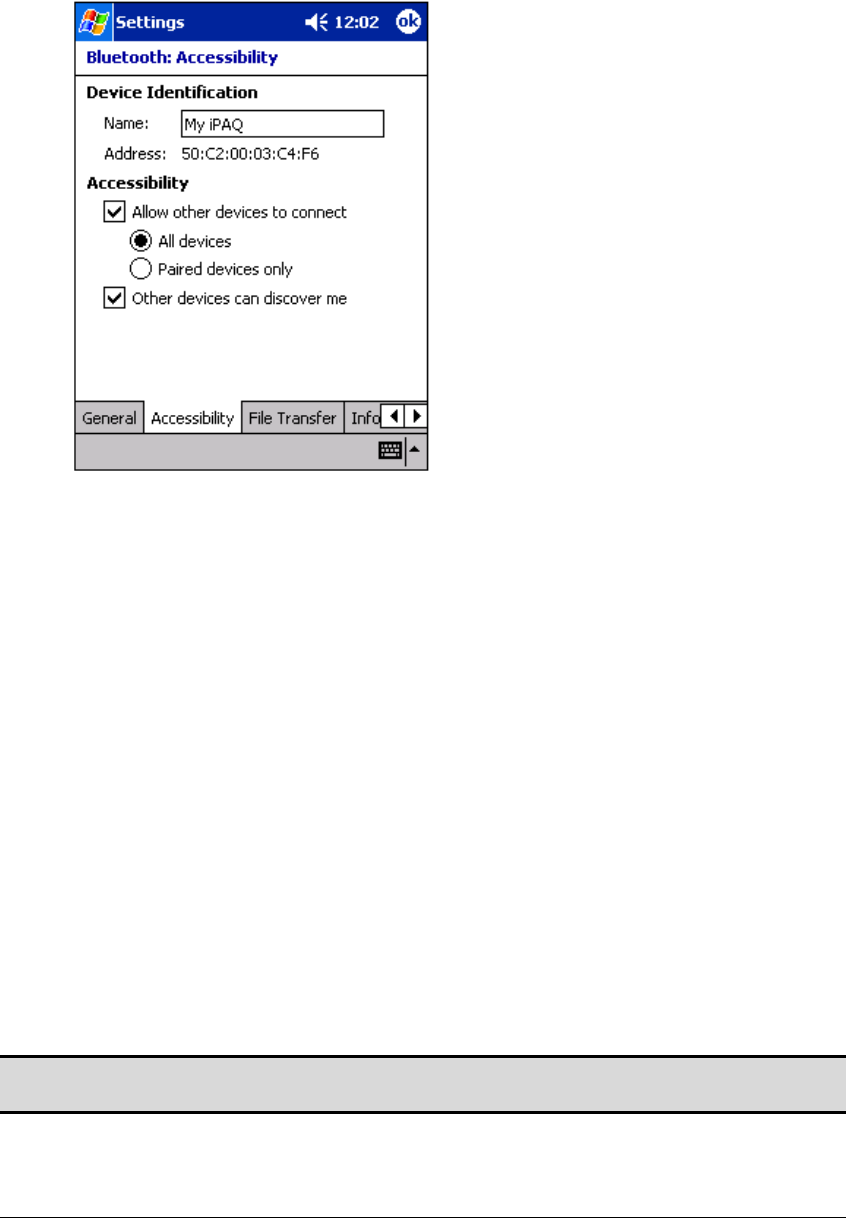
BTW-CE User’s Guide Control Panel
10
2.2 ACCESSIBILITY TAB
Figure 6: Control Panel, Accessibility tab
All information on this tab is saved with the active profile, including the device name.
The options on the Accessibility tab are:
• Device Identification:
Name—the name of this device, as displayed to remote devices when the
associated profile is active. To change the device name associated with this
profile, highlight the name and enter the new name.
Address—the Bluetooth Device Address (BDA) of this device. This
information is permanently associated with the Bluetooth hardware during
the manufacturing process and cannot be changed.
• Accessibility:
Allow other devices to connect—when this option is enabled, other devices
are permitted to connect to this device. Two mutually exclusive sub-options
provide additional refinement. They are:
All devices—select this option to allow all devices to connect.
Paired devices only—select this option to allow only devices that have a
paired relationship (see Section 3.2.2.1) with this device to connect.
Other devices can discover me—when this option is enabled, other Bluetooth
devices can see and report this device.
Even though remote devices cannot discover this device unless this option is
checked, if a remote device has this device’s Bluetooth Device Address, that
device may still be able to connect to this device (see Note below).
NOTE: The ability of remote devices to connect is also subject to security restrictions and
whether Bluetooth is enabled on this device.

BTW-CE User’s Guide Control Panel
11
2.3 BTW-CE SERVICE TABS
The functions that a Pocket PC can provide to other devices are called “Services.”
The services that this Pocket PC is capable of providing are:
• File Transfer—file-related operations such as get a file/use a file/delete a file, etc.
• Information Exchange—Send the default business card (Pocket Outlook contact)
on request.
• Serial Port—Bluetooth serial port operations. Bluetooth serial ports are used as a
replacement for a physical cable between devices.
• Dial-up Networking—provide access, via a phone line or other access system, to
a remote computer network such as an Internet service.
Each of these tabs is explained in detail in the remainder of this section.
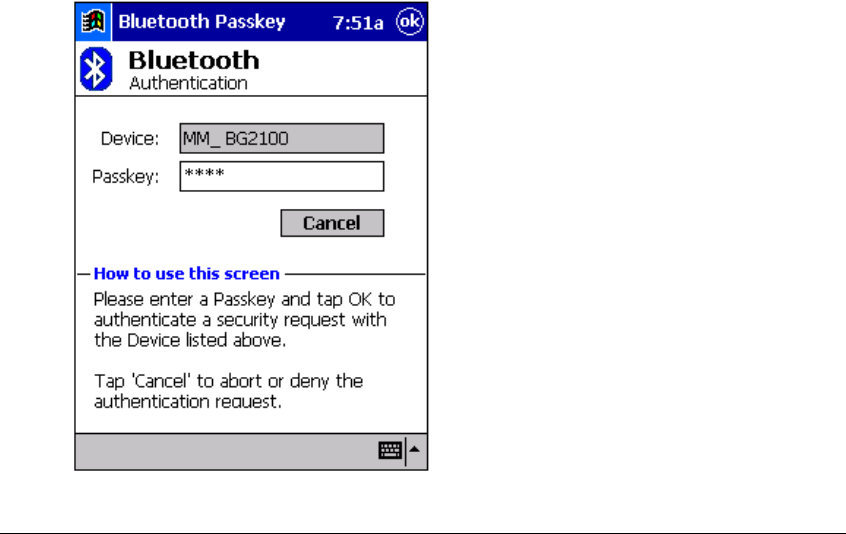
BTW-CE User’s Guide Control Panel
12
2.3.1 Common Options
All of the services have some common settings. Even though the options are the same, in
each case they are specific to the service being configured on the individual tabs.
The common options are listed under the About this service heading on each individual
service tab. They are:
• Enable service: check this option to have the service start when BTW-CE
initializes. When this option is enabled the service is enabled and “listening” for
connection attempts when Bluetooth is enabled.
• Authorization required: check this option to require that each attempt to
establish a connection be individually authorized. When Authorization is enabled
and a remote device attempts to connect to this service, BTW-CE asks if the
connection should be permitted (see also Section 3.2.2.2, Permissions).
• Authentication (PIN) required: check this option to require a Personal
Identification Number (PIN code, also called a password or passkey) or a Link
Key from the remote device before allowing the connection.
When this option is enabled and a remote device attempts to establish a
connection, the Bluetooth Passkey screen (Figure 7) appears. Enter the passkey
to allow the connection to proceed, or tap the OK button to deny permission for
the connection.
If the notification is ignored, the connection attempt will time out (fail).
• Encryption required: check this option to require that all the data exchanged
between this device and the remote Bluetooth device be encrypted.
Encryption depends on the key that is used for Authentication; if Authentication
is not enabled, Encryption will not be available.
Only the data exchanged by the Bluetooth devices is encrypted.
The individual services, and their unique options, are explained in the remainder of this
section.
Figure 7: Bluetooth Passkey screen
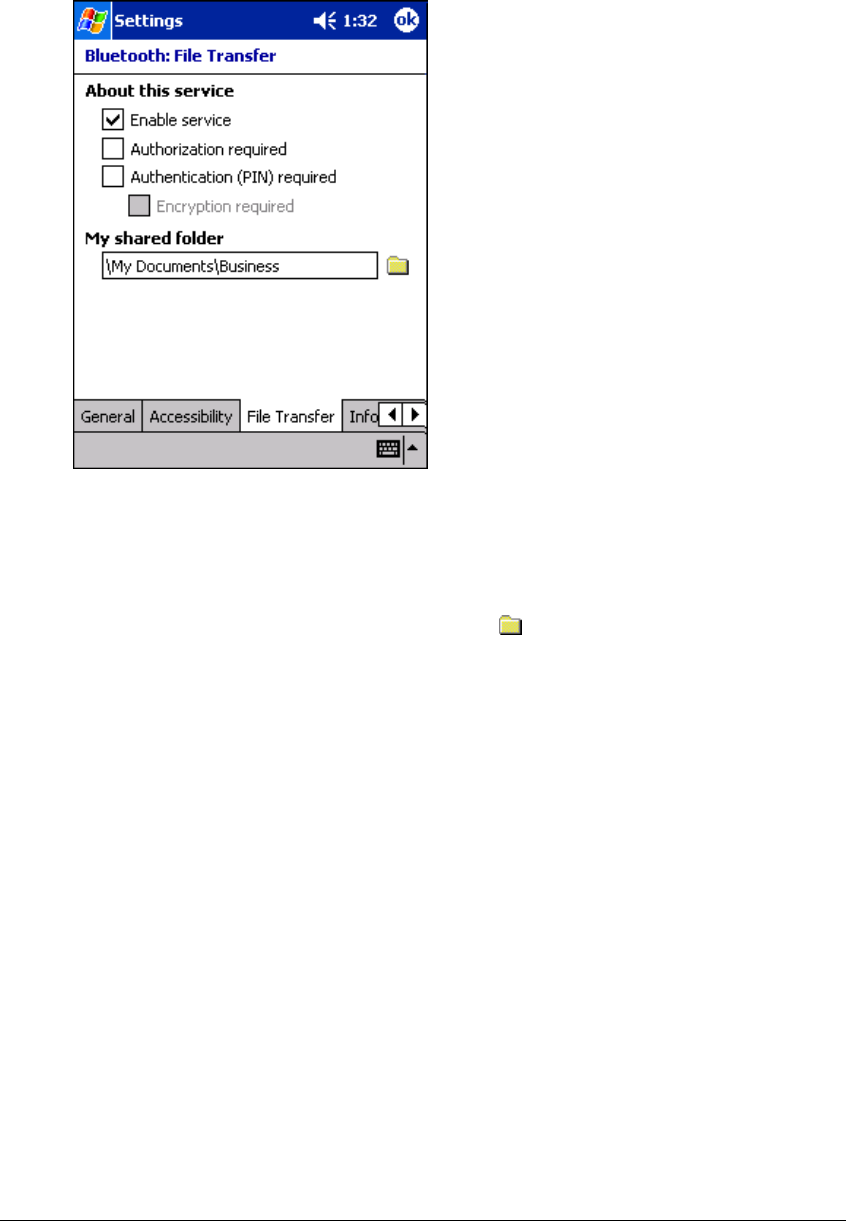
BTW-CE User’s Guide Control Panel
13
2.3.2 File Transfer Tab
Figure 8: Control Panel, File Transfer tab
The options on this tab only affect incoming File Transfer connections.
All of the Common Options (see Section 2.3.1) are available.
There is one additional configurable item: “My shared folder,” which allows you to
specify the default File Transfer directory, the highest level directory on this Pocket PC
that remote devices have access to.
To change the default File Transfer directory, tap , navigate to the desired directory,
and then tap the OK button.
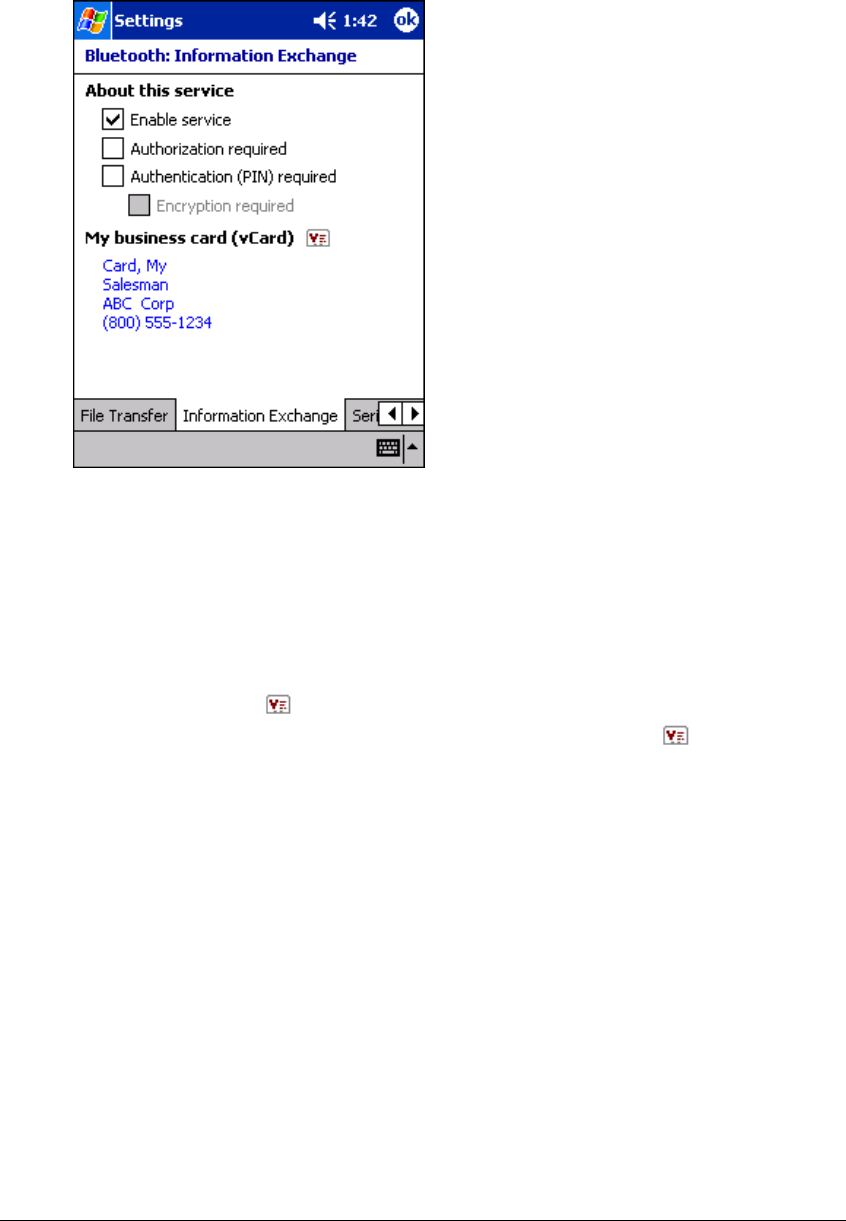
BTW-CE User’s Guide Control Panel
14
2.3.3 Information Exchange Tab
Figure 9: Control Panel, Information Exchange tab
The Common Options (see Section 2.3.1) on this tab only affect incoming Information
Exchange connections.
There is one additional configurable item: “My business card (vCard)”.
The “My business card” information comes from a selected record in the Contacts list of
Pocket Outlook. Information from the selected record is sent to remote devices on request.
It is also the contact information that is sent when you select “Send your business card to
one or more recipients” while using Business Card Exchange.
The default selection is “none” (no information).
To select a vCard, tap , choose a contact from the list, and then tap OK.
To discontinue sending contact information when it is requested, tap , choose “(none)”
from the list, and then tap OK.
If you reach the contacts list by mistake, tap OK to return to the previous screen.
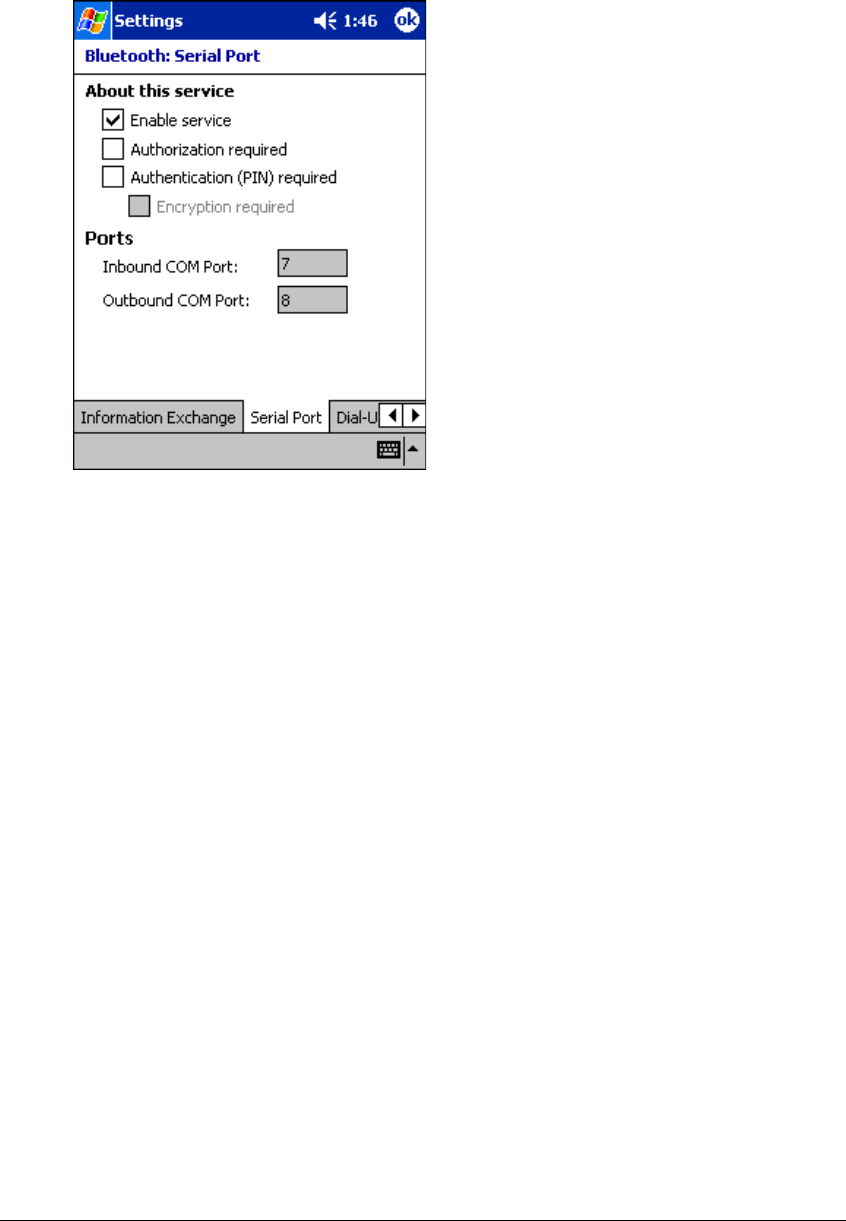
BTW-CE User’s Guide Control Panel
15
2.3.4 Serial Port Tab
Figure 10: Control Panel, Serial Port tab
The options on this tab only affect incoming Serial Port connections.
All of the Common Options (see Section 2.3.1) are available.
There are two additional, non-configurable items:
• Inbound COM Port: the local communications port that is used for inbound
serial connections.
• Outbound COM Port: the local communications port that is used for
outbound serial connections.
The Inbound and Outbound COM ports are permanently assigned and cannot be changed.
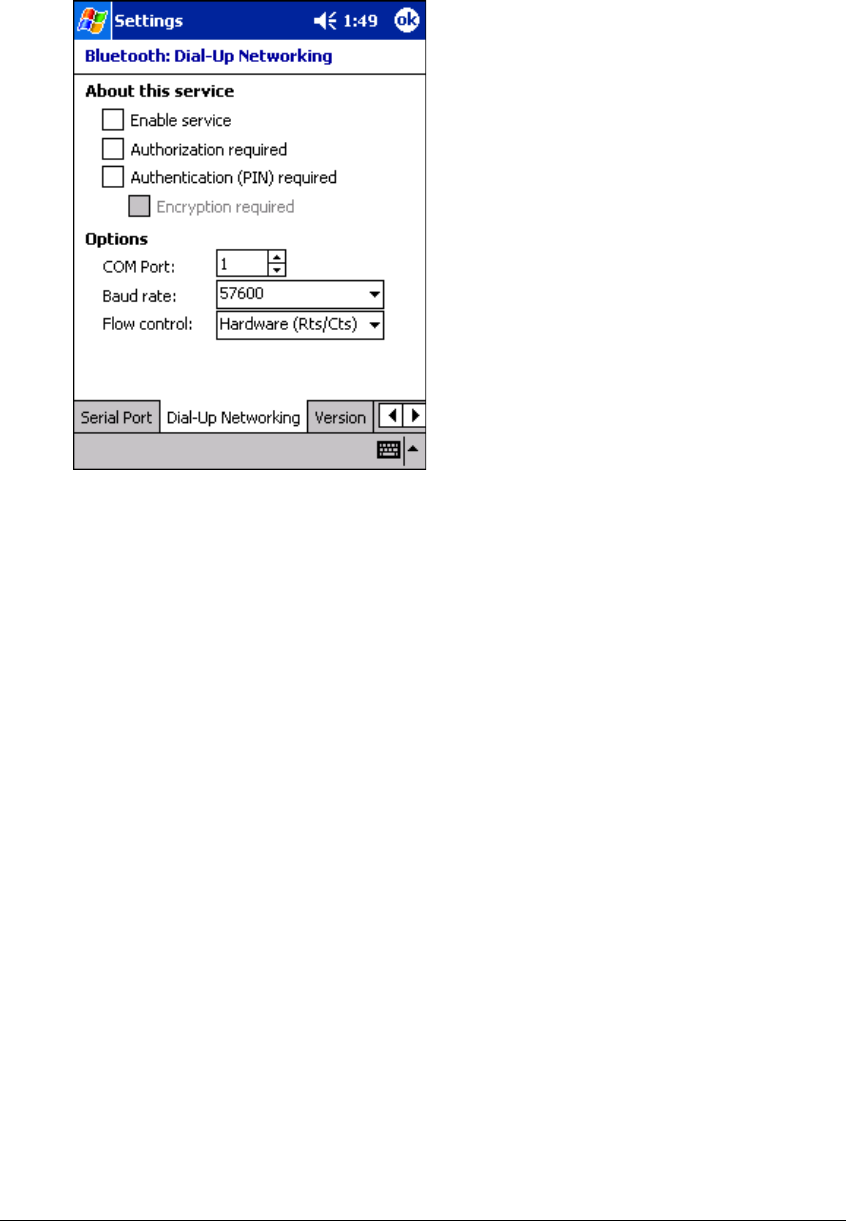
BTW-CE User’s Guide Control Panel
16
2.3.5 Dial-up Networking Tab
Figure 11: Control Panel, Dial-up Networking tab
The options on this tab only affect incoming Dial-up Networking connections.
All of the Common Options (see Section 2.3.1) are available.
There are three additional items:
• COM Port: select the communications port to be used.
• Baud rate: tap the down-arrow and select a baud rate from the drop-down list.
The options range from 1,200 to 115,200 baud, in nine steps.
• Flow control: tap the down-arrow and select the type of flow control to be used
from the drop-down list. The options are:
Off
Hardware (Rts/Cts).
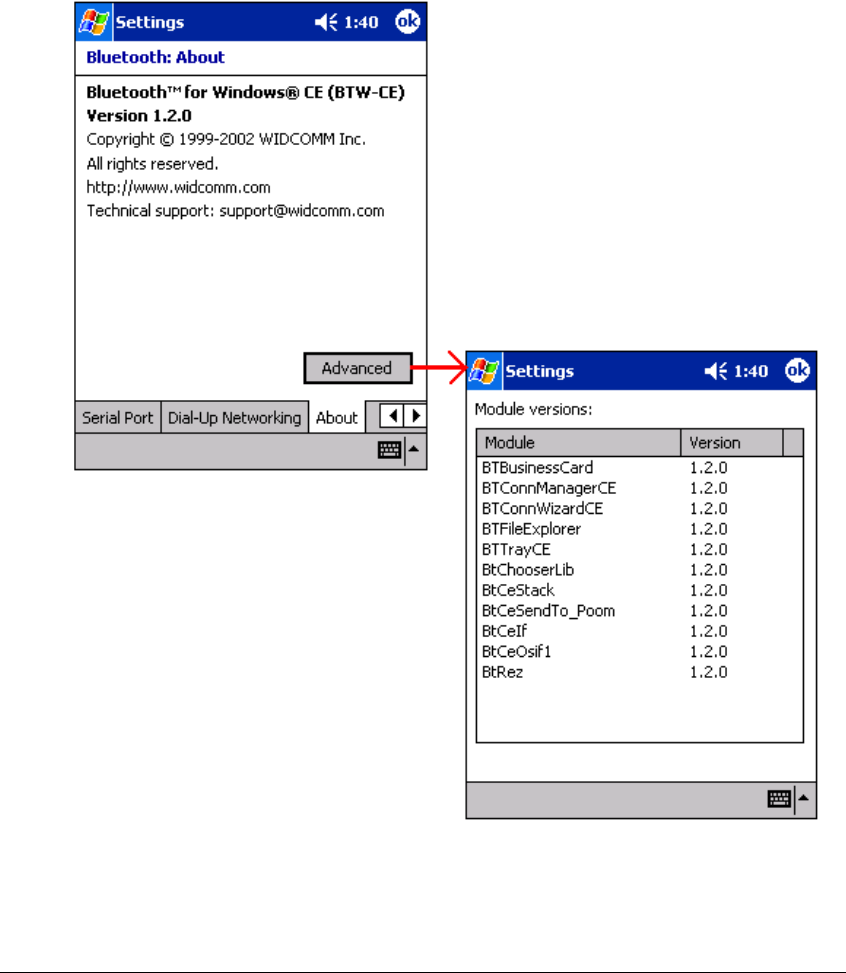
BTW-CE User’s Guide Control Panel
17
2.4 ABOUT TAB
This tab provides:
• Release Version information
• Copyright notice
• Website address
• Technical support email contact address
• An Advanced Button, which displays a screen that contains version information
about the individual software modules that make up BTW-CE.
There are no configurable options on this tab.
Figure 12: Control Panel, About tab
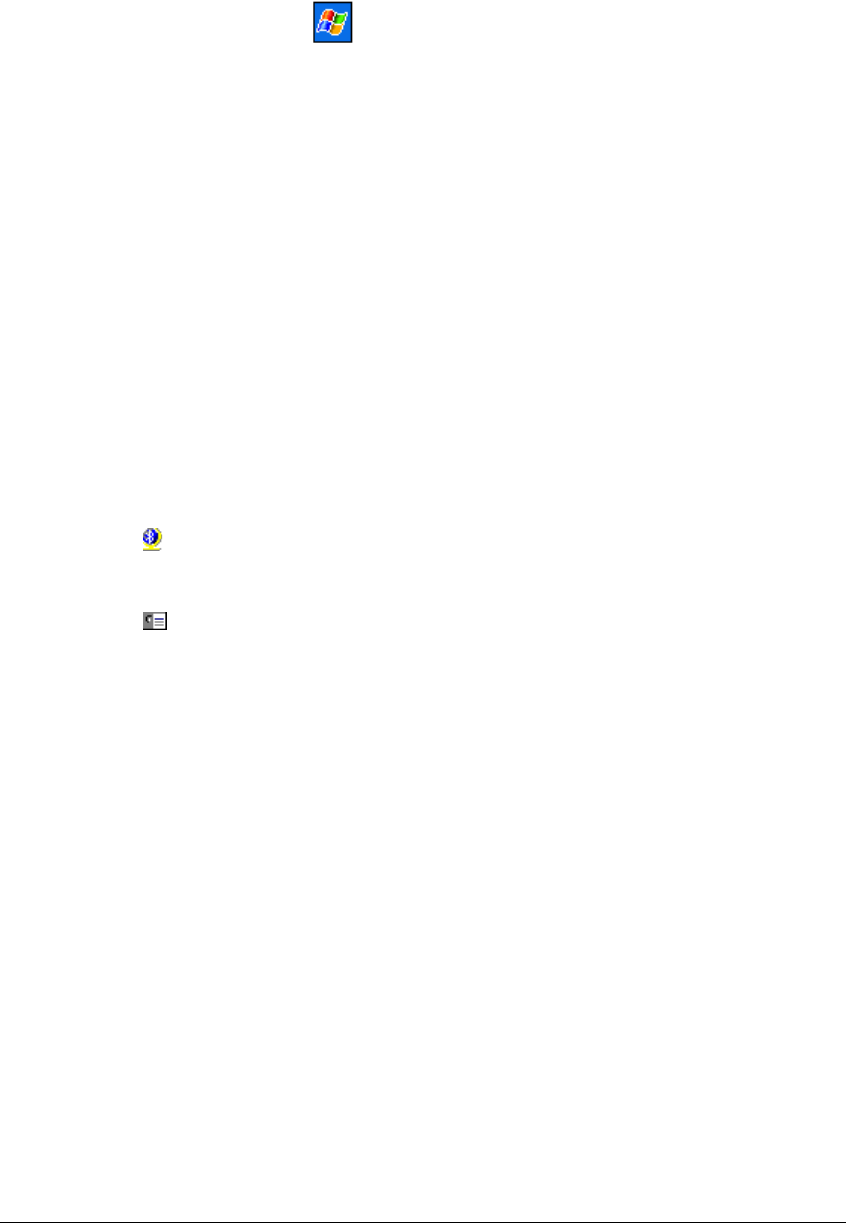
BTW-CE User’s Guide Bluetooth Manager
18
3 Bluetooth Manager: Using BTW-CE
To access the Bluetooth Manager:
From the Today screen, tap > Programs > Bluetooth Manager.
The Bluetooth Manager has (see Figure 13):
• Two tabs:
My shortcuts—displays shortcuts and establishes connections
Active Connections—displays active incoming and outgoing connections
• Three menus:
New
Connection shortcut…—create a new connection shortcut using the
Bluetooth Connection Wizard
Temporary connection…—create a connection without creating a
permanent shortcut.
Security
Trusted devices—pair/un-pair with other devices
Permissions—determine which services are offered, on an individual
basis, to trusted devices.
View—controls the on-screen display (icons or list).
• Two icons:
Accesses the Bluetooth Connection Wizard, which helps you setup
connections with remote Bluetooth devices. This icon is a shortcut to the
New > Connection shortcut… menu item.
Accesses the Bluetooth Business Card Exchange screen, which allows you to:
Get a business card from a remote device
Send your business card to a remote device
Exchange business cards with a remote Bluetooth device.
These options are explained in detail in the remainder of this section.
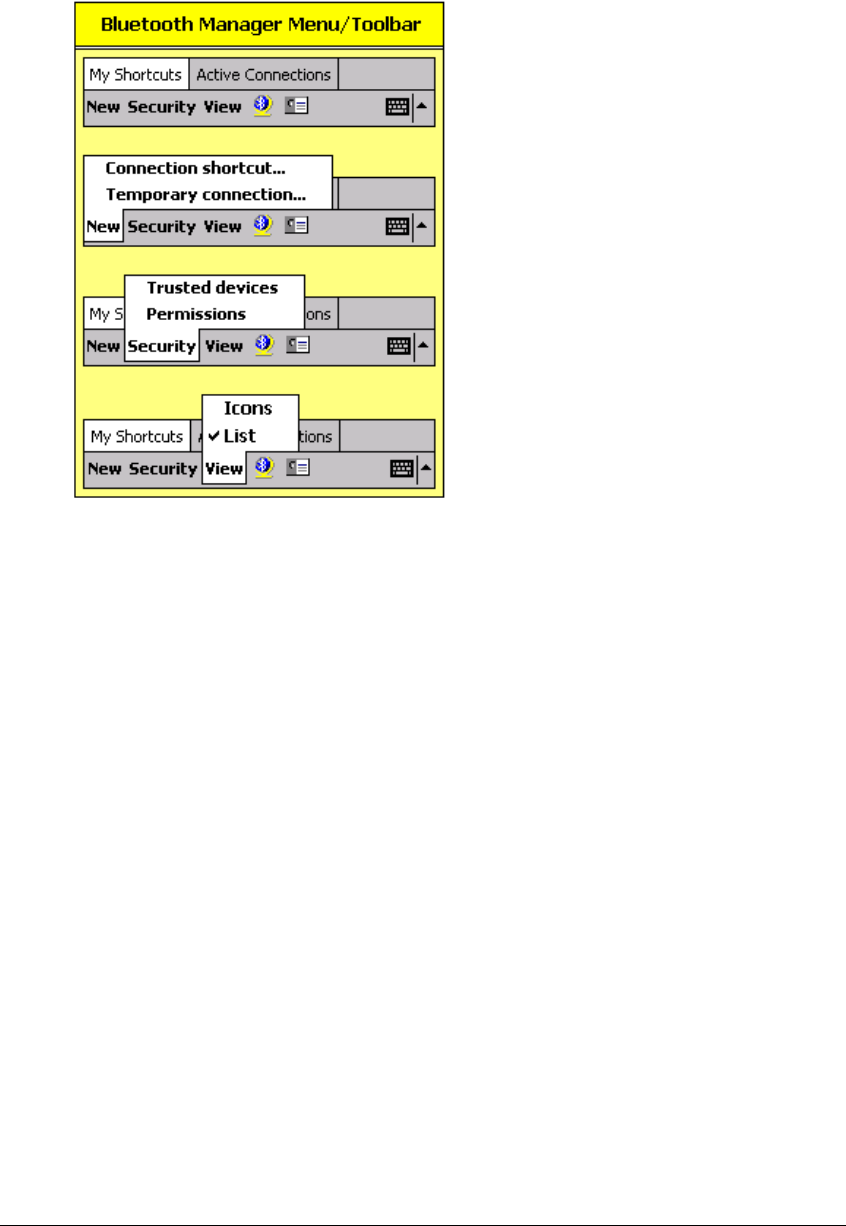
BTW-CE User’s Guide Bluetooth Manager
19
Figure 13: Bluetooth Manager Menu/Toolbar

BTW-CE User’s Guide Bluetooth Manager
20
3.1 TABS
The two tabs at the bottom of the Bluetooth Manager screen are:
• My shortcuts
• Active Connections.
3.1.1 My Shortcuts Tab
The default tab on the Bluetooth Manager is My Shortcuts. This screen displays the
shortcuts that have been created for connections to other devices. The shortcut icons
provide visual feedback about the status of the connection they are linked to (see
Figure 14).
Figure 14: Connection status displayed by icon color
The double-tap is context sensitive:
• If the connection is not open—double-tap the shortcut to establish a connection
• If the connection is open—double-tap the shortcut to display the connection
Status screen (Figure 15).
Connections can also be opened/closed, and other options accessed, using the
tap-and-hold technique. If you tap a shortcut and hold the stylus in place for a few
seconds, a context sensitive menu appears.
The options on the context sensitive menu are dependant on the state of the connection:
• Connection open
• Connection not open.
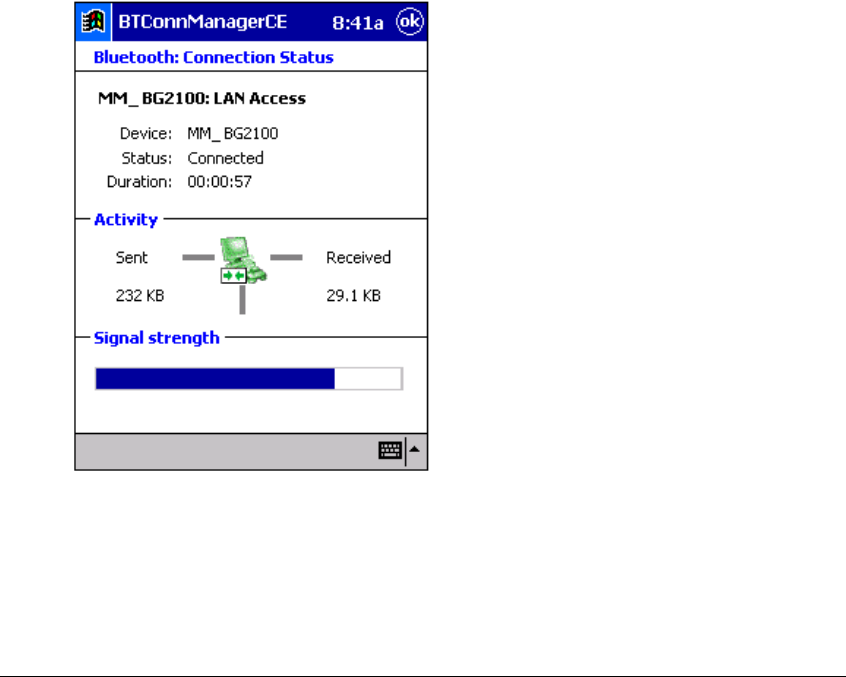
BTW-CE User’s Guide Bluetooth Manager
21
3.1.1.1 Connection Open—Context Sensitive Menu Options
From the My Shortcuts screen, tap-and-hold a connection shortcut that is associated with
an OPEN connection to access the context sensitive menu.
The Menu options are:
• Disconnect—close the open connection
• Status—select this option to display the Connection Status screen (Figure 15)
(double-tap default)
• View Icons—displays the shortcuts as large icons
• View List—displays the shortcuts as a list with small icons.
3.1.1.2 Connection Status Screen
This screen displays:
The connection’s name
The remote device’s name
The connection status: Connected/Not Connected
The length of time the connection has been active
Activity information:
Bytes Sent
Bytes Received
A graphic signal strength indicator.
Figure 15: Connection Status screen

BTW-CE User’s Guide Bluetooth Manager
22
3.1.1.3 Connection Inactive—Context Sensitive Menu Options
From the My Shortcuts screen, tap-and-hold a connection shortcut that is associated with
an INACTIVE connection to access the context sensitive menu.
The menu options are:
• Connect—select this option to establish a connection (double-tap default).
• Rename—select this option to rename the shortcut. This option is often used to
rename shortcuts that were created in a group (see Section 3.2.1.1 for information
about creating shortcuts); when multiple shortcuts are created at the same time
they are given default names and no option is provided at that point to change the
default.
• Delete—select this option to permanently delete the shortcut.
• Properties—select this option to display the Connection Properties screen
(Figure 16).
• View Icons—displays the shortcuts as large icons
• View List—displays the shortcuts as a list with small icons.
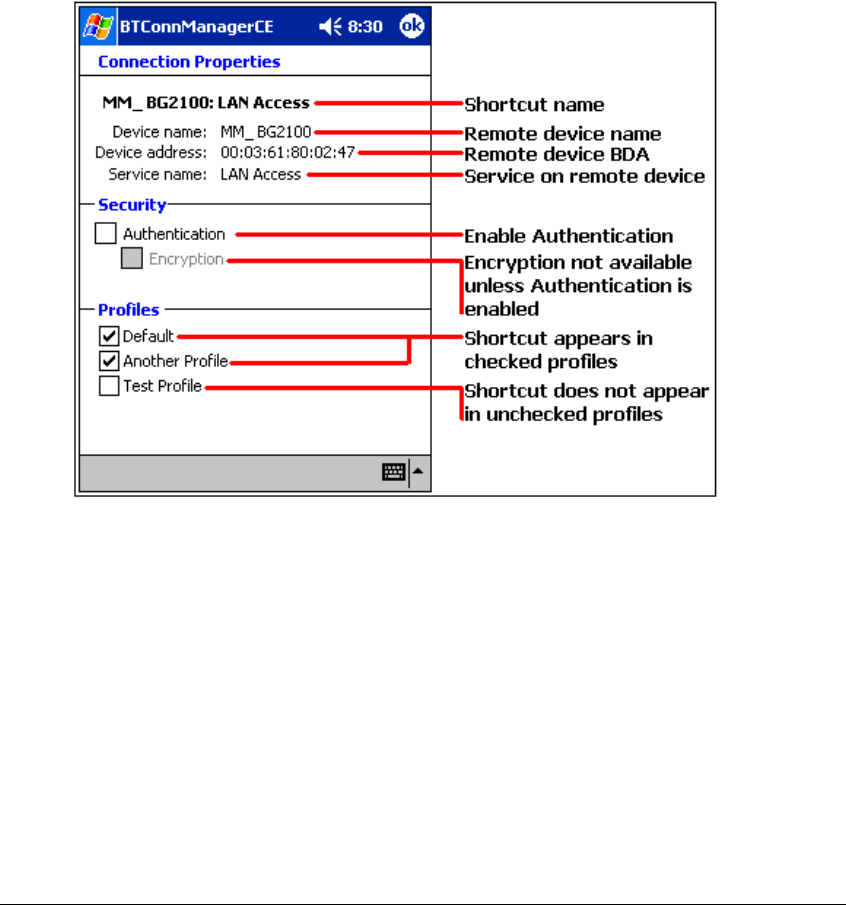
BTW-CE User’s Guide Bluetooth Manager
23
3.1.1.4 Connection Properties Screen
This screen displays:
The connection’s name
Connection Properties—non-configurable information about the remote
device, including:
The remote device name
The remote device Bluetooth Device Address (BDA)
The name of the service on the remote device that this shortcut accesses.
Security—enable/disable Authentication and Encryption.
Profiles—a list of the available profiles on this device. To assign, or remove,
this connection shortcut to/from a profile, select or clear the profile’s
associated check box.
Figure 16: Connection Properties screen
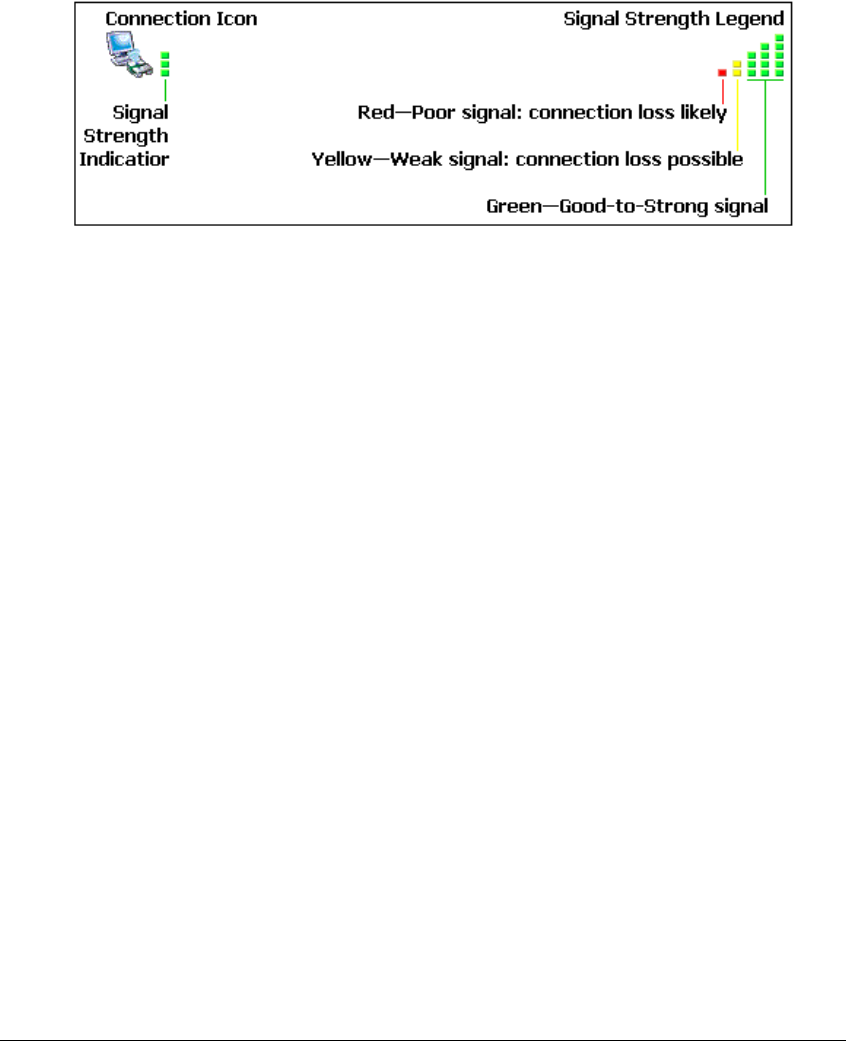
BTW-CE User’s Guide Bluetooth Manager
24
3.1.2 Active Connections Tab
This tab displays the currently active Outgoing and Incoming Connections on the
Pocket PC.
To the right of each active connection icon is a signal strength indicator (Figure 17).
Tap-and-hold a connection to access a context sensitive menu. The menu options are:
• Disconnect—close this connection
• Status—display the connection Status screen (Section 3.1.1.2 and Figure 15).
Figure 17: Active Connections screen, signal strength indicator
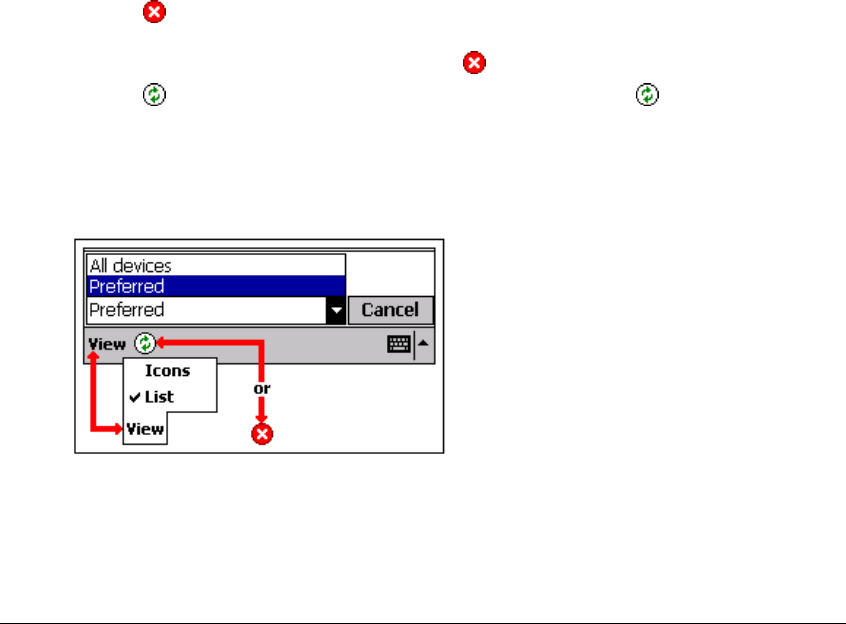
BTW-CE User’s Guide Bluetooth Manager
25
3.2 MENUS
There are three menus on the bottom of the Bluetooth Manager. They are:
• New
• Security
• View.
3.2.1 New
The New menu has two options. They are:
• Connection shortcut…
• Temporary connection….
When either of these options is selected the Bluetooth Connection Wizard walks you
through the process of creating the shortcut or temporary connection.
The “Select a device:” screen on the wizard asks you to select a device that offers the
service you want to use. Located at the bottom of this wizard screen (Figure 18) are:
• A drop-down menu with two options:
Preferred—when this option is selected the wizard attempts to display only
those devices that offer the desired service.
All devices—select this option to have the wizard display all devices in the
vicinity, without regard to the type of service(s) they offer.
• The View menu, which has two options:
Icons—displays the found devices as large icons
List—displays the found devices in a list.
• An icon—the icon that is displayed is determined by what the wizard is doing:
The wizard is searching for devices. When the desired device appears on the
screen, tap the device to select it and stop the search.
To stop an in-process search, tap .
The wizard has completed its search for devices. Tap to search again or
refresh the screen.
• Cancel button—tap this button to close the “Select a device:” screen and return to
the previous screen without changing the selected device.
Figure 18: Bottom of the Select a device wizard screen (composite overview)

BTW-CE User’s Guide Bluetooth Manager
26
3.2.1.1 Connection shortcut…
The “Connection shortcut…” menu option creates a shortcut to one or more services on a
remote device, but does not establish a connection.
A shortcut to each selected service appears on the My Shortcuts tab of the Bluetooth
Manager. To use the connection, double-tap the shortcut, or tap-and-hold and select
Connect from the popup menu.
To create a new shortcut:
1. From the Bluetooth Manager’s New menu, select Connection Shortcut…
(or tap ) to start the Bluetooth Connection Wizard:
2. On the first wizard screen, choose either:
a) “Show all services, let me pick later.” This is the default option; when it is
selected BTW-CE will display all devices in the vicinity on a future wizard
screen—after a device is chosen from that list, all services provided by that
device will be displayed, and you will be able to pick one or more services
for which shortcuts will be created.
Or
b) Tap a specific type of service. When a specific type of service is selected,
BTW-CE displays only those devices that potentially offer that service.
When the wizard is complete, only the chosen service on the chosen device
will have a shortcut placed on the My Shortcuts screen.
3. Tap the Next button to display the second wizard screen, and:
a) Tap to display the “Select a device:” screen. Tap a device name: BTW-CE
returns to the second wizard screen and populates the “Select a device:” field
with the chosen device.
b) Tap the Secure Connection option to enable Authentication and Encryption,
if desired.
When this option is enabled, the Pass Key Needed screen (similar to the
screen in Figure 7) appears. Enter the correct code in the Passkey field and
tap the Next button. A dialog box appears while pairing takes place and the
services offered by the device are discovered, and then the wizard
automatically precedes to the last screen.
Even when this option is NOT enabled, if Authentication is enabled on the
remote device, a PIN code will be required the first time a connection is
attempted.
4. Tap the Next button to display the last screen, tap the selection box of each
service for which a shortcut should be created, and then tap the Finish button. A
shortcut for each selected service is placed on the My Shortcuts screen and given
a default name.
If a specific service was chosen in step 1b, the last screen is different; it does not allow
you to select a service other than the one specified in step 1b. The displayed screen
(Figure 19) instead provides additional information about the selected service, including:
1. The name of the device that will provide the service.
2. The name of the service to be provided.
3. A “Connection name:” field, which contains the default name for this shortcut;
the shortcut name can be changed before proceeding. To change the name,
highlight it, enter the new name, and then tap the Finish button.
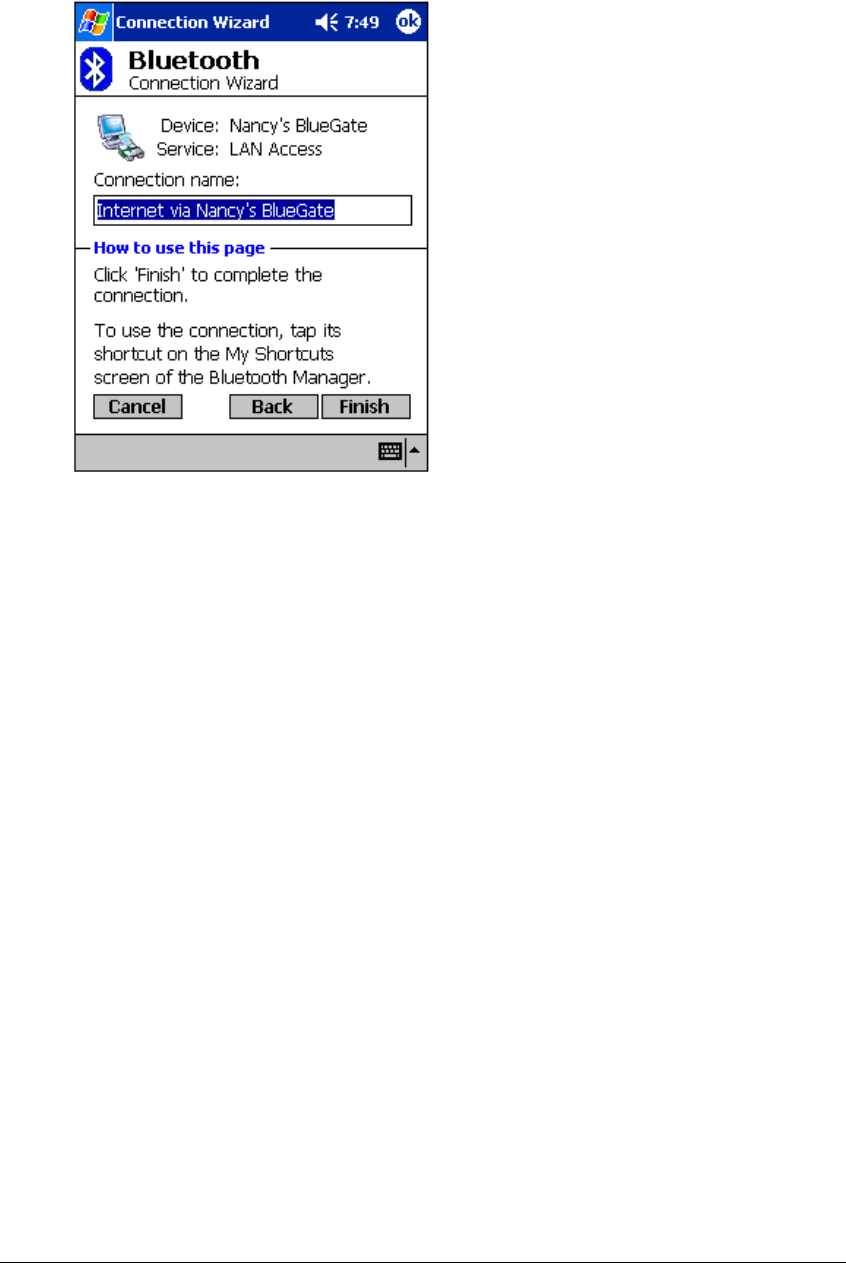
BTW-CE User’s Guide Bluetooth Manager
27
Figure 19: Connection Wizard, specific service chosen, last screen

BTW-CE User’s Guide Bluetooth Manager
28
3.2.1.2 Temporary connection…
A temporary connection may be useful in some situations, for example when accessing a
public printer while traveling.
Temporary Connection, in this context, means that a permanent shortcut is not placed on
the My Shortcuts screen. The connection is, however, associated with the QuickConnect
icon on the My Shortcuts screen.
The QuickConnect icon will always establish a connection to the most recently used
temporary connection.
To Create a Temporary Connection, from the Bluetooth Manager’s New menu, select
“Temporary Connection….”
The connection wizard will walk you through the process of establishing the new
connection; the process is the same as that for creating a new connection shortcut (see
Section 3.2.1.1) with the following exceptions:
• Multiple connections cannot be created.
• No permanent shortcut is placed on the My Shortcuts screen.
If the QuickConnect shortcut is deleted, the next time a temporary connection is created
the QuickConnect shortcut will be re-created.
If the QuickConnect shortcut is renamed and then deleted, the next time a temporary
connection is created the shortcut will be re-created with its default name (QuickConnect).

BTW-CE User’s Guide Bluetooth Manager
29
3.2.2 Security
The Security menu has two options. They are:
• Trusted devices
• Permissions.
3.2.2.1 Trusted devices
Trusted Devices are those devices that have been “paired” with this Pocket PC.
When two devices have been paired they share, and exchange prior to each connection,
an internally-generated security key. This security key, called a Link Key, is based on a
unique Bluetooth Device Address, a random number, and a user-defined password.
To pair with another device:
1. From the Bluetooth Manager, Security menu, select “Trusted devices…”
2. On the Trusted devices screen, tap New
3. On the Device Pairing screen:
a) Tap
b) Tap a device on the “Select a Bluetooth device” screen to return to the prior
screen and populate the “Device:” field.
c) Enter the correct password in the “Passkey:” field
4. Tap OK.
To Break (Remove) a Paired Relationship
1. From the Bluetooth Manager, Security menu, select “Trusted devices…”
2. Tap a device name to select it
3. Tap the Delete button, and then tap Yes in the confirmation dialog.
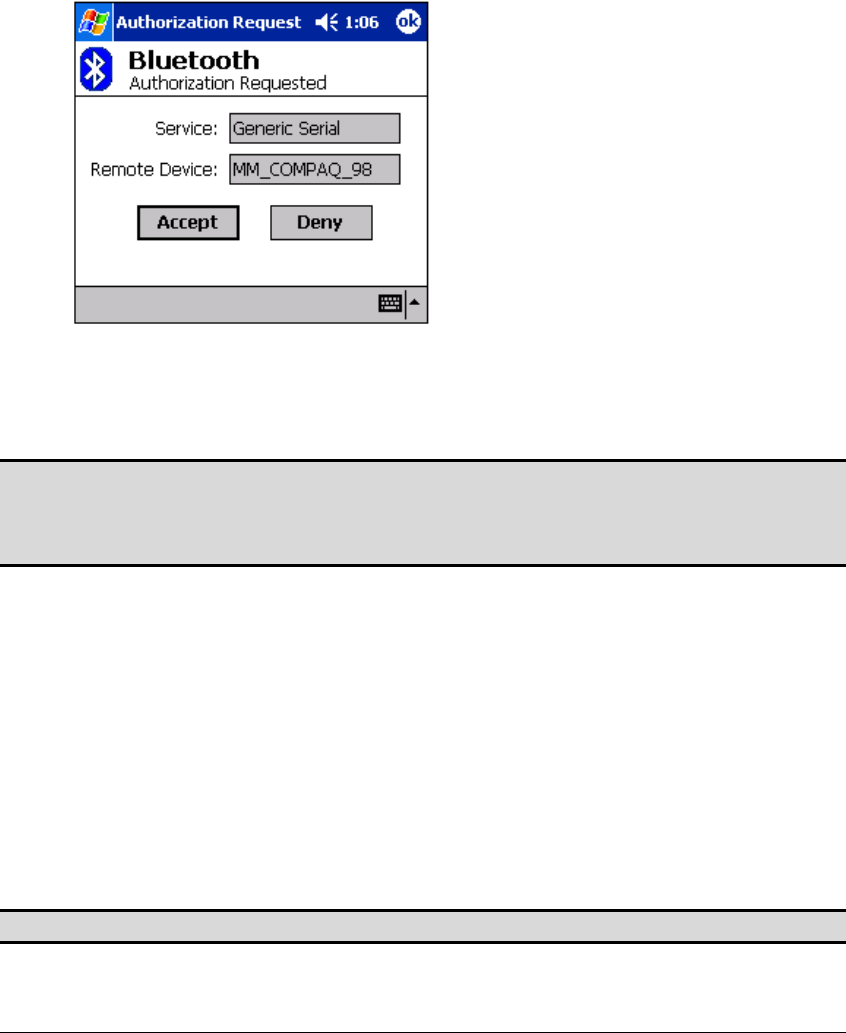
BTW-CE User’s Guide Bluetooth Manager
30
3.2.2.2 Permissions
To understand Permissions you must understand Authorization.
Authorization is, in essence, a way of saying Yes or No; “May I use this service?” “Yes
(or No)” is the answer.
When Authorization is enabled for a service (see Section 2.3.1) and a remote device
attempts to access that service, the Authorization Requested screen appears (Figure 20);
you must tap the Accept or the Deny button to proceed. Even if the connection times out
(fails), you must still tap a button to clear the screen and proceed with normal activity.
Figure 20: Authorization Requested
When a remote device is paired (see Trusted Devices, Section 3.2.2.1) with this
Pocket PC, Authorization can be handled automatically, on a service-by-service basis.
Permissions lets you specify which of the services provided by this Pocket PC that a
specific paired device is automatically authorized to use, provided the service being
authorized has Authorization enabled.
NOTE: If a service does not have Authorization enabled, setting permissions for a paired device
that uses that service will have no effect. However, the Permissions settings are saved in
the current profile; if Authorization is enabled for this service in the future, Permissions
will take effect.
By default, when a device pairs with this Pocket PC, that device is authorized to use all of
the Pocket PC’s services.
To modify Permissions for a Paired Device:
From the Bluetooth Manager, Security menu, select Permissions:
1. Tap a device name to select it (only paired devices appear in the list)
2. Select the services that the device is automatically permitted to use by selecting
or clearing the boxes in front of the service names.
3. Tap OK to return to the My Shortcuts screen.
Services for which Permissions have been granted will bypass the Authorization
Requested screen; services for which Permissions have NOT been granted will still
require you to press the Accept or Deny button on the Authorization Requested screen
before allowing the connection to proceed.
NOTE: Permissions do not affect devices that are not paired with the Pocket PC.
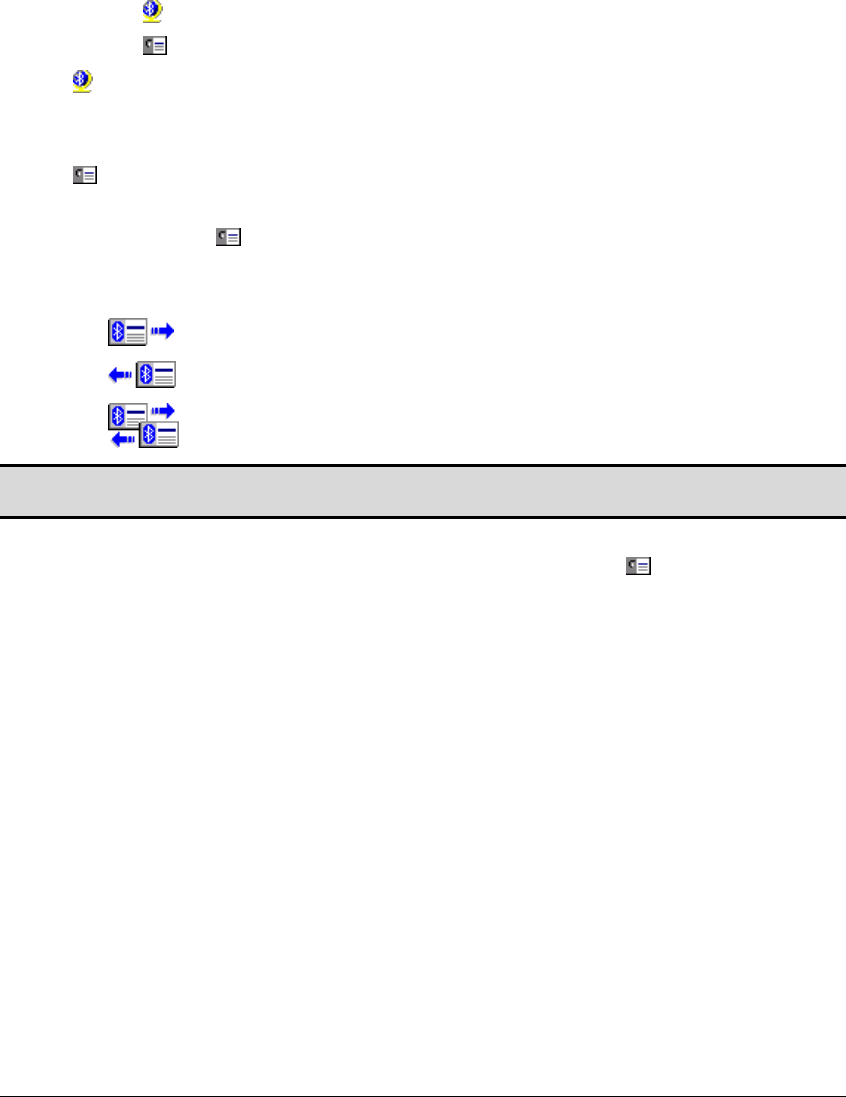
BTW-CE User’s Guide Bluetooth Manager
31
3.2.3 View
The View menu has two options. They are:
• Icons—select this option to view the on-screen shortcuts as large icons
• List—select this option to view the on-screen shortcut in list format.
3.3 ICONS
There are two icon shortcuts on the bottom the Bluetooth Manager screen. They are:
• New connection shortcut
• Business Card Exchange
3.3.1 New Connection Shortcut
This icon is a shortcut to the New > Connection shortcut… menu item. See
Section 3.2.1.1 for information on how to create a new connection shortcut.
3.3.2 Business Card Exchange
Business Card Exchange is accessible from:
• An icon on the Bluetooth Manager’s menu bar
• From Start > Programs > Card Exchange.
Business Card Exchange allows you to:
Send your business card to one or more remote devices.
Request a business card from one or more remote devices
Exchange business cards with one or more remote devices.
NOTE: To Send or Exchange business card(s) you must first specify your default business card in the
Bluetooth Control Panel, Information Exchange tab (see Section 2.3.3).
To Send, Request or Exchange Business Cards
1. From the Bluetooth Manager, tap the business card icon .
2. Tap the Send, Request or Exchange icon, as appropriate
3. From the “Select a Bluetooth device” screen, tap the name of the remote device
and then tap OK.
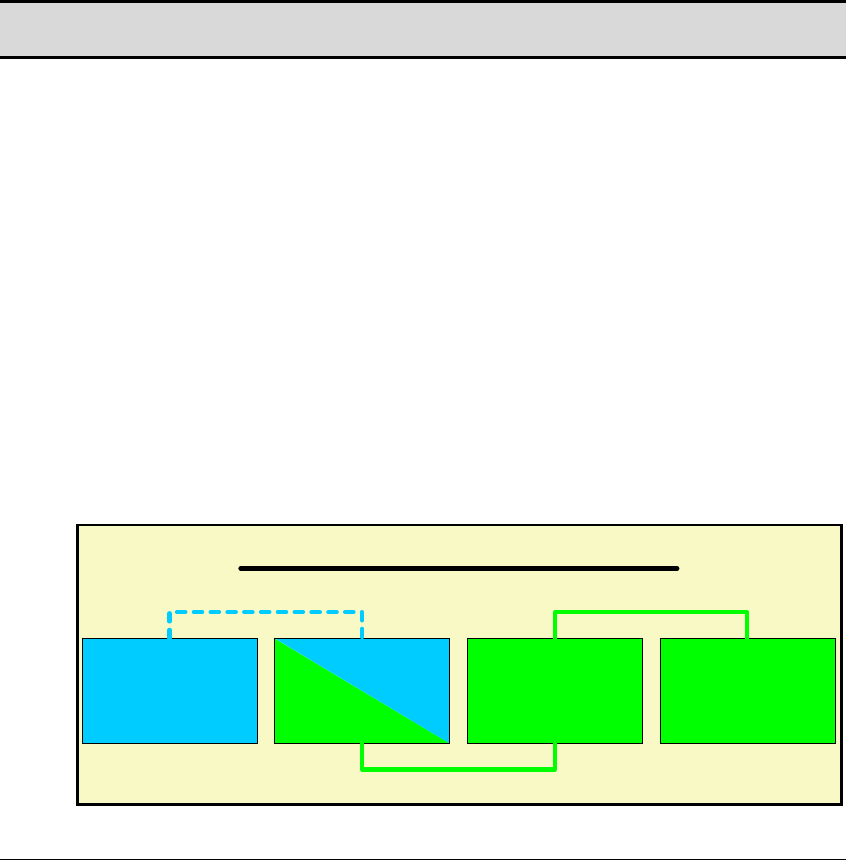
BTW-CE User’s Guide Using Remote Services
32
4 Using Remote Device Services
This section provides overview instructions for using services provided by other devices.
4.1 SERIAL PORT
The use of a Bluetooth wireless serial port connection is identical to the use of a physical
cable serial port connection between two devices.
As with a physical connection, the application that will use the connection must be
configured to use the correct serial port.
To determine the communications port assigned to the Bluetooth serial port:
1. From the Today Screen, tap the Bluetooth icon to open the Bluetooth Control
Panel.
2. Use the scroll arrows at the bottom-right of the screen to expose the Serial Port
tab, and then select the Serial Port tab.
The Outbound COM Port is listed in the lower portion of the screen.
Configure the application that will use the Bluetooth Serial Port to send data to
this port.
NOTE: For information about configuring your application’s outbound COM port, refer to the
application’s documentation.
3. From Bluetooth Manager’s My Shortcuts screen open the Bluetooth serial port
connection to the remote device.
4. Send/Receive data from the application.
4.2 DIAL-UP NETWORKING: CONNECT TO A REMOTE COMPUTER
Dial-up Networking allows you to connect to a remote computer via a phone line. Once
connected, you can browse the Internet, check your email, etc.
The remote Bluetooth device that will provide the Dial-up Networking service must have
access to a telephone system (either a physical or cellular connection).
Devices that might provide the Dial-up Networking service include:
• Bluetooth-enabled cellular telephones
• Bluetooth-enabled desktop computers that are attached to a telephone system
• Bluetooth modems.
The remote computer to which you are connecting must also be attached to the phone
system and capable of answering a call.
Figure 21: Dial-up Networking overview
Bluetooth Pocket PC
Device that provides
Telepone access
(Bluetooth Cell Phone,
Bluetooth Modem...)
Telephone system
Bluetooth "over-the-air" connection
Remote Computer
Cellular or Physical connection
Cellular or Physical connection
Bluetooth Dial-up Networking Overview
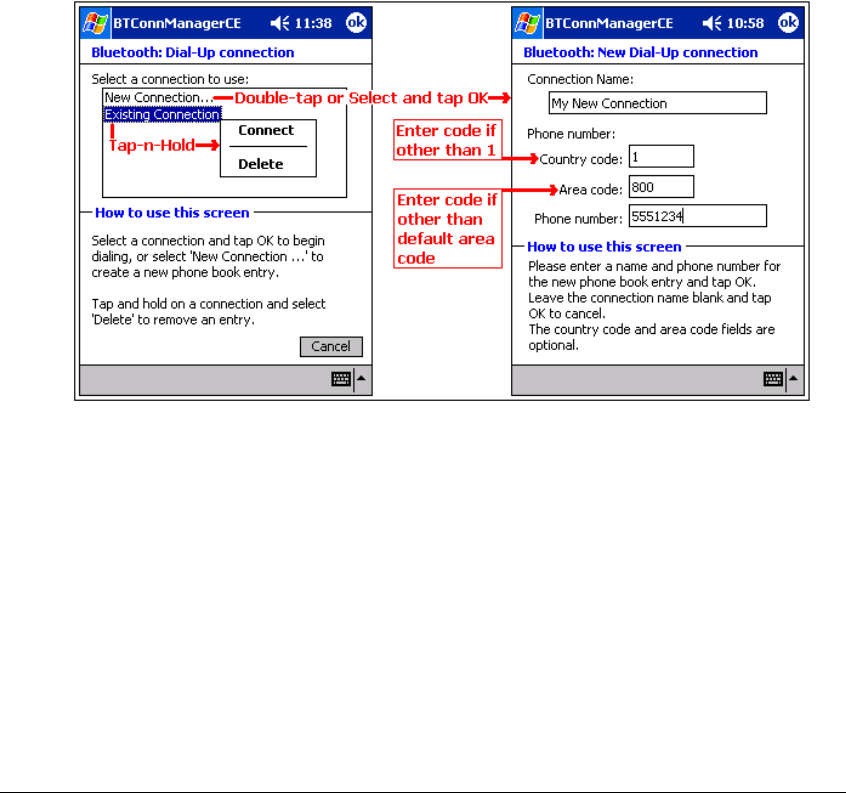
BTW-CE User’s Guide Using Remote Services
33
To use Dial-up Networking:
1. Create a shortcut to the device that will provide telephone access (see
Section 3.2.1.1).
2. From the Bluetooth Manager, My Shortcuts tab, tap-and-hold the Dial-up
Networking connection shortcut, and then select Connect from the pop-up menu.
3. On the first Bluetooth: New Dial-up Connection screen (Figure 22, left), double-
tap New Connection…
4. On the second Bluetooth: New Dial-up Connection screen (Figure 22, right):
a) Enter a name for the connection
b) If dialing outside of the default country setting, enter the country code
c) If dialing outside of the default area code setting, enter the area code
d) Enter the phone number to be dialed.
5. Tap OK
To proceed with the connection, you must complete the Windows CE screen(s) that
follow(s). Refer to the Windows CE documentation for assistance.
After the connection is active, open a web browser on the Pocket PC.
Figure 22: Dial-up Networking, overview (composite screenshot)

BTW-CE User’s Guide Using Remote Services
34
4.3 BLUETOOTH FILE EXPLORER
Bluetooth File Explorer appears automatically when a File Transfer connection is
established. It allows you to:
• Navigate the directory structure of the remote device
• View files and folders on the remote device
• Create new folders on the remote device
• Send files to, and Get files from the remote device
• Delete files on the remote device.
NOTE: File operations on the remote device are limited to the remote device’s configured FTP
root directory and its sub-directories.
Bluetooth File Explorer also allows you to set the folder on your Pocket PC that will
receive inbound files. This folder is configurable on an individual basis for each
connection shortcut.
Bluetooth File Explorer has two menus:
• File:
Send a File…
Create a Folder
Get
Delete.
• Tools:
Set Local Folder
Refresh.
Figure 23 on the next page is an overview of Bluetooth File Explorer.
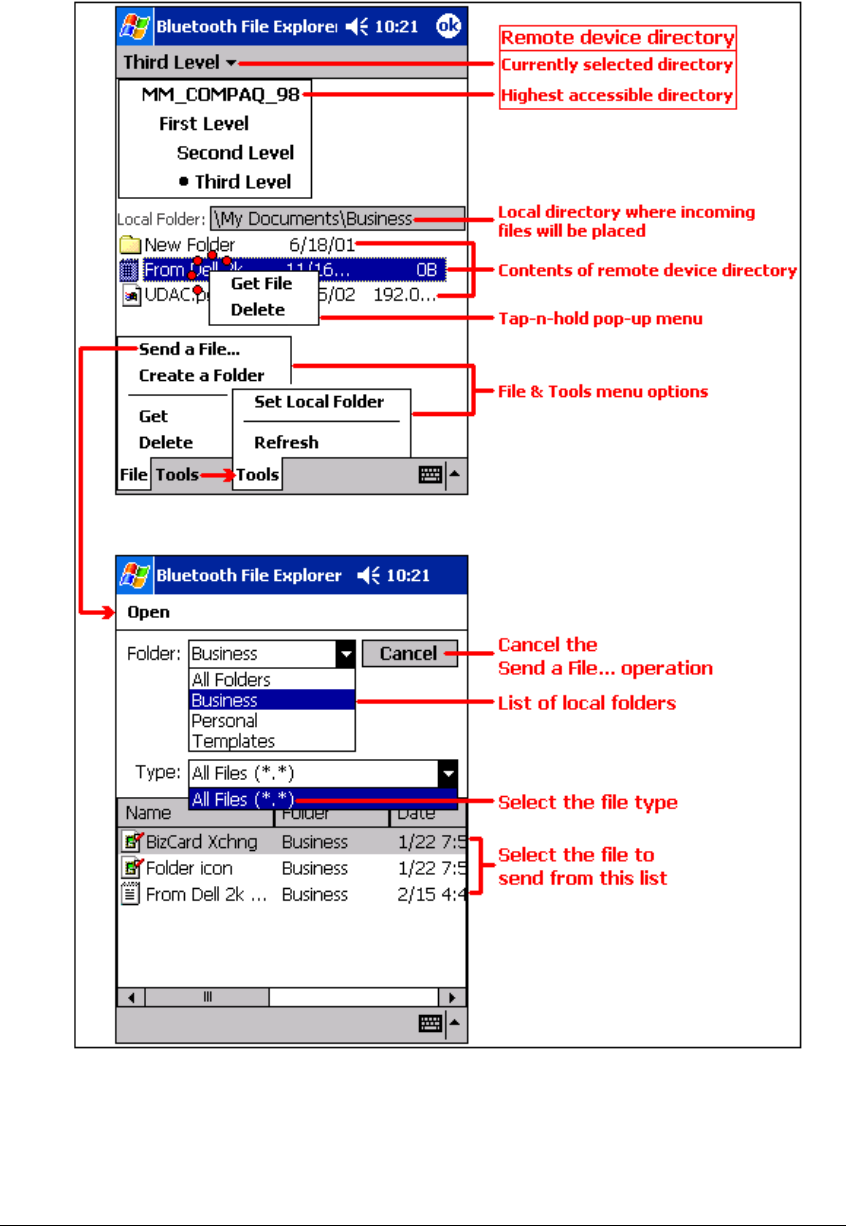
BTW-CE User’s Guide Using Remote Services
35
Figure 23: Bluetooth File Explorer overview (composite screenshot)

BTW-CE User’s Guide Using Remote Services
36
4.3.1 Change the Remote Device Folder
To move down in the directory structure of the remote device, tap the new folder in the
main portion of the Bluetooth File Explorer window.
To move up in the directory structure of the remote device, tap the down-arrow to the
right of the currently selected folder and select the new folder from the drop-down list.
4.3.2 File Menu
All of the instructions in the subsections that follow assume that there is an open File
Transfer connection with a remote device.
4.3.2.1 Send a File to the Remote Device
To send a file to the remote device, from the File menu, tap Send a File… to display the
Open screen.
The options on the Open screen are:
• Folder—tap the down-arrow and select the folder that contains the file to be sent.
• Type—the only option is “All Files (*. *)
• A list of files in the selected folder; tap the file to be sent
• Cancel button—aborts the Send a File… operation.
The selected file is sent automatically when it is tapped, without further intervention, and
the Bluetooth File Explorer main screen reappears.
4.3.2.2 Create a Folder on the Remote Device
To create a folder on the remote device, navigate to the folder in which the new folder
will be placed, and then, from the File menu, tap Create a Folder. Enter a name for the
new folder while the default name (New Folder) is highlighted.
4.3.2.3 Get a File From the Remote Device
To get a file from the remote device:
1. Navigate to the folder on the remote device that contains the file
2. Tap the desired file to highlight it
3. From the File menu, tap Get.
The file is copied to the local folder listed in the Local Folder field near the top of the
screen.
This operation can also be performed using the tap-and-hold technique: tap-and-hold the
desired file and select Get from the pop-up menu.
4.3.2.4 Delete a File on the Remote Device
To delete a file on the remote device: tap the file to be deleted to highlight it, then, from
the File menu, tap delete. Tap OK in the confirmation dialog box.
This operation can also be performed using the tap-and-hold technique: tap-and-hold the
desired file and select Delete from the pop-up menu. Tap OK in the confirmation dialog
box.
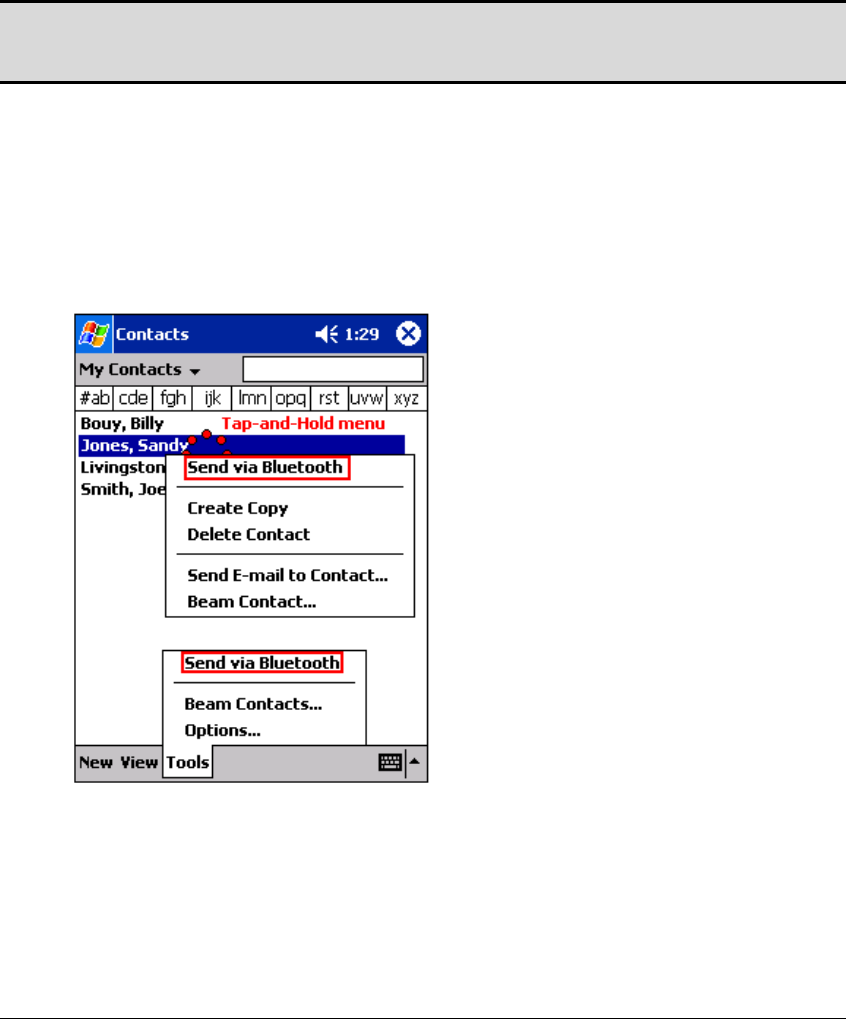
BTW-CE User’s Guide Using Remote Services
37
4.3.3 Tools Menu
4.3.3.1 Set Local Folder
The local folder, i.e. the folder on the Pocket PC where incoming files are placed, can be
configured on an individual basis for each connection shortcut.
To configure the local folder:
1. From the Tools menu, tap Set Local Folder
2. Use the drop-down menu at the top of the screen to navigate to the desired folder
3. Tap OK to return to the Bluetooth File Explorer main screen.
The Local Folder field is updated to reflect the new folder selection.
NOTE: The Local Folder information is associated with the shortcut to the connection that is
open and is saved with the active profile. A different Local Folder can be associated with
each File Transfer shortcut.
4.3.3.2 Refresh
To refresh the list of displayed files and folders on the remote device, from the Tools
menu, tap Refresh.
4.4 SEND VIA BLUETOOTH
Pocket Outlook contacts, calendar items, and tasks can be sent individually or
collectively to a remote device.
Figure 24: Send via Bluetooth menus
To send data via Bluetooth transfer:
1. From the Start menu, Programs, open Calendar, Contacts or Tasks
2. Highlight the item(s) to be sent
3. Tap-and-hold the item(s), and from the pop-up menu, tap Send via Bluetooth.
4. On the Select a Bluetooth device screen, tap the name of the destination device,
and then tap OK.